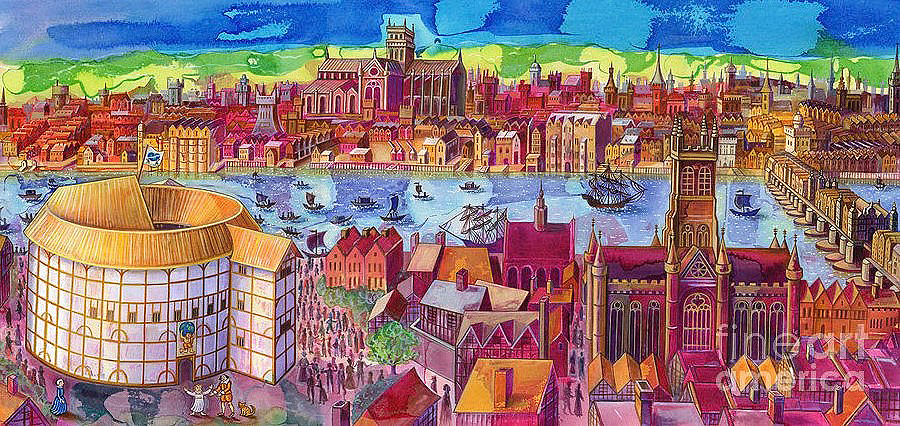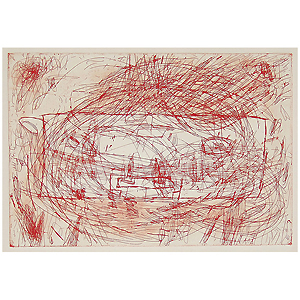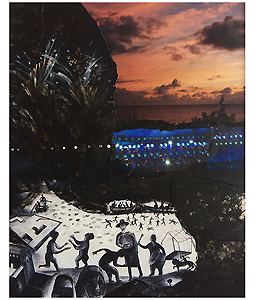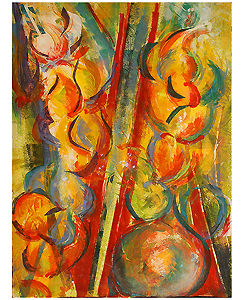| AZOTH
ART FORUM
An open art & history forum & BLOG (below). |
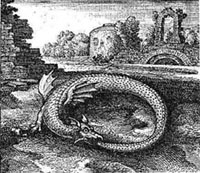 |
Flight from miss muffett on Vimeo.
>https://newversenews.blogspot.com/2022/06/assanged.html
ASSANGED
by Lisa Seidenberg

WikiLeaks founder Julian Assange (above) to the United States,
where he faces espionage charges, in a decision his organization said marked
a "dark day for press freedom." —CNN, June 17, 2022
For publishing classified documents
Of military strikes on innocents
Hits on civilians and wartime blunders
In Iraq and Afghanistan, in shocking numbers
It was not a surprise they took him down
Debating if he is journalist
Assange was a one man wanted list
Sheltered for years in the
Embassy of Equador
Until they booted him out the door
His mental state, on view, alarming
But, even so, could still be quite charming
Befriended Pamela Lee, a Hollywood alum
Then fathered two babies and married their mum
While passing the hours awaiting a decision
By London magistrates on his extradition
Why does one choose a life
so perilous
When most of us risk so much less?
Or did Julian not know what fate would hold
For one who opted to be so bold
To defy the FBI
And the CIA
To imagine they would look the other way?
In a more principled world - but not today.
Present day martyrs like
Assange and Navalny
Join those in history who took a stand
And paid a high price with stern reprimand
For the crime of speaking truth to power
And not run away—or cower
I would not do so but let us pause to admire
Those who step out of line and into the fire.
Lisa Seidenberg is a writer and filmmaker residing in Connecticut. Twitter:
@Leeside33
I think I could turn and live with animals, they are so placid and self-contain’d,
I stand and look at them long and long.
They do not sweat
and whine about their condition,
They do not lie awake in the dark and weep for their sins,
They do not make me sick discussing their duty to God,
Not one is dissatisfied, not one is demented with the mania of owning
things,
Not one kneels to another, nor to his kind that lived thousands of years
ago,
Not one is respectable or unhappy over the whole earth.
~Walt Whitman
Dear AzothGallery Friends,
It is with profound sadness, grief and heartbreak that I announce the sudden passing of my dear life-long friend Ray Coutant on January 6th, 2019, in Delaware. ... I first met Ray in 1964 when he sponsored so-called "T-Groups" (Therapy) at the Fairfield YMCA (CT) where he was Director. Ray held a PhD in Communications, and was a researcher on the 18th & 19th centuries development of Hegel's philosophy and its early influence on Psychoanalysis. In the 1950s, he served in the US Navy and participated in the development of advanced SONAR systems. These "T-groups" focused on therapeutic and philosophical discussions and greatly advanced my thinking on mental health and psychological individuality. In early 1968, Ray graciously invited engineer Pat Setanni and myself to use his electronic sound modulators and synthesizer at the Y to create my first electronic composition "Polarity Synchronicity."
Just in late December 2018, Ray had just launched his new web-site "Psychologism: Hegel in Phenomenology of Spirit"
Ray Coutant has had a profound influence on my life and he is very deeply missed! He and his wife Tempa live in Delaware. I will soon transcribe my many notebooks of our monthly hours-long philosophical telephone discussions and will post these texts on this blog.
I invite anyone who knew Ray to please contact me -- Thanks!
~ Johnes 203.668.6933
Psychologism is a philosophical position, according to which psychology plays a central role in grounding or explaining some other, non-psychological type of fact or law. (Wikipedia)
Hegel
in Phenomenology of Spirit. "Consciousness is spirit as concrete,
self-aware knowledge."
Essay outline by Ray Coutant, PhD
Hegel, an early 19th Century philosopher, labeled his metaphysical system as the science of Spirit. The spiritual process is to evolve consciousness in the universe eventually through the aid of human intellectual products both conscious and unconscious to man. Hegel built a new logic based, not on the immediate world of obvious relations, but on the intricate patterns of language forms leading to thoughts, which he proposed in some aspect, reflected the workings of spirit. Here then, humans could produce creative products in reflection of the creative process of the Universe. Rejecting the empirical, mechanical methods of a static mental perspective, but through introspection and thought experiments, Hegel proposed a dynamic system of a spiraling-web interplay restructuring mental perspectives he called Dialectics. This paradigm preserved the past mental states but created new ones through new viewpoints giving the thinker greater freedom in creative possibilities but greater complexity in his products.
The Universe is also evolving in consciousness and the result is more and more complexity. There are two points here: Technologies without metaphysics cannot adapt with primitive Ego functions such as repression and neurosis, and they will need to be expanded with the development of poetry, music, mathematics, etc.
We will study two other thinkers who came to similar viewpoints: Nietzsche and Freud as well as more contemporary thinkers.
The Institute for Absolute Psychologism is a free university being developed with courses, lectures, seminars dealing with this paradigm and it is free to anyone who wishes to attend. We plan to have several meeting areas close to the Amtrak line from Washington D.C to New Haven, Connecticut with our offices in Newark, Delaware. Please sign up to receive a newsletter of our progress we plan to finalize early in 2019 and receive more extended position papers to help you prepare for your education.
Thank you,
Ray Coutant
Ph D. (December 18, 1933 - January 6, 2019)
Manager http://absolutepsy.org/
Herbert Marcuse -- REASON AND REVOLUTION
Preface - A Note on Dialectic
Herbert Marcuse -- Preface: A Note on Dialectic
Audio Reading by Johnes Ruta - entirety of 8 pages
Norman O. Brown (1913-2002)
The Archetype Lecture May 9, 1966 University of Rochester
Author: Life Against Death (a psychoanalytical view of history) 1959;
Hermes the Thief, 1948;
Hesiod's Theogony, 1953;
Love's Body, 1966.
The Dialectics of Slavery
Lecture by George Tolmie, Phd. Sociology, M.S.W. (1942-2016)
October 24, 1967 -- The 1967 Silvermine Art Center Lectures
Part 1
Part 2
Audio Readings from William James - THE VARIETIES OF RELIGIOUS EXPERIENCE (1902) - exerpts from Lectures 16 & 17 Mysticism: Read by Johnes Ruta.
1. J.A. Sysmonds (1840-1893) English poet, literary critic, cultural historian: The cosmic sensation of the Self...
2. Armiel's "Journey InTime" : Reveries on the Milky Way...
3. Malwida-von-Metsenbug: The world-encircling Harmony...
4. Walt Whitman : I believe in you, my Soul! ...
5. Richard Maurice Bucke (1837-1902): COSMIC CONSCIOUSNESS ...
6. YOGA: the hidden way of the Soul ...
********************************************************************************************************************************
A Time-Lapse Rocket Ride to the Top of 1 World Trade CenterOne of our most popular videos on Facebook this year: Step inside the elevators at 1 World Trade Center and witness 515 years of history unfolding at the tip of Manhattan.
Posted by The New York Times on Monday, December 28, 2015
-- Essay outline by Johnes Ruta, independent curator & art theorist, 1996.
Art Links
The
Sublime: philosophical selections by Longinus Edmund Burke, Immanuel
Kant, & Wordsworth
a brilliant short essay by Janice E. Patten, faculty of San Jose State
University.
Edmund Burke (1729-1797)
: A Philosophical Inquiry into the Origin
of Our Ideas of The Sublime and Beautiful (Bartleby.com -
complete text)
Longinus
on the Sense of the SUBLIME The
Web Gallery contains over 8,500 digital reproductions of European
paintings
and sculptures created between the years 1150 and 1800.
http://www.wga.hu/index1.html
Northern Renaissance Art
Metropolitan Museum
of Art, New York City
The Artcyclopedia
Gallery
Worldwide -contemporary art
A
Guide for translating symbolism in Renaissance art:
Caesar Ripa (fl. England, 1600) -- "ICONOLOGIA or
Moral Emblems
various images of virtues, vices, paffions, arts, Humours, elements &
celeftial bodies"
Caesar
Ripa's ICONOLOGIA transcribed by Rawn Clark on Adam McLean's Alchemy
website.
The
William Blake Archive
mythos by Robert Graves
That will prove worth your telling,
Whether as learned bard or gifted child;
To it all lines or lesser gauds belong
That startle with their shining
Such common stories as they stray into.
Is it of trees you tell,
their months and virtues,
Or strange beasts that beset you,
Of birds that croak at you the Triple will?
Or of the Zodiac and how slow it turns
Below the Boreal Crown,
Prison to all true kings that ever reigned?
Water to water, ark again
to ark,
From woman back to woman:
So each new victim treads unfalteringly
The never altered circuit of his fate,
Bringing twelve peers as witness
Both to his starry rise and starry fall.
Or is it of the Virgin's
silver beauty,
All fish below the thighs?
She in her left hand bears a leafy quince;
When, with her right hand she crooks a finger, smiling,
How may the King hold back?
Royally then he barters life for love.
Or of the undying snake from
chaos hatched,
Whose coils contain the ocean,
Into whose chops with naked sword he springs,
Then in black water, tangled by the reeds,
Battles three days and nights,
To be spewed up beside her scalloped shore?
Much snow is falling, winds
roar hollowly,
The owl hoots from the elder,
Fear in your heart cries to the loving-cup:
Sorrow to sorrow as the sparks fly upward.
The log groans and confesses:
There is one story and one story only.
Dwell on her graciousness,
dwell on her smiling,
Do not forget what flowers
The great boar trampled down in ivy time.
Her brow was creamy as the crested wave,
Her sea-blue eyes were wild
But nothing promised that is not performed.
Robert Graves
poem by Samuel Taylor Comeridge (1772-1834)
read by ORSON WELLES (1915-1985)
illustrations by Gustav Dore' (1832-1883)
His two eternal notes of “I and Thou”
O! hearken well, for soon the song sings true
And, would we hear it, we must hear it now
The bird of life
is singing in the sun
Short is his song, nor only just begun
A call, a trill, a rapture, then -- so soon!
A silence, and the song is done - - is done
Yea! What is man
that deems himself divine?
Man is a flagon, and his soul the wine;
Man is a reed, his soul the sound therein;
Man is the lantern, and his soul the shine
Would you be happy,
hearken, then the way
Heed not TO-MORROW, heed not YESTERDAY
The magic words of life are HERE and NOW
O fools, that after some tomorrow stray
Were I a Sultan,
say what greater bliss
Were I to summon to my side than this
Dear gleaming face, far brighter than the moon
O love! and this immortalizing kiss
To all of us the
thought of heaven is dear
Why not be sure of it and make it here?
No doubt there is a heaven yonder too
But ’tis so far away - and you are near
Men talk of heaven
- there is no heaven but here
Men talk of hell - there is no hell but here
Men of hereafters talk, and future lives
O love, there is no other life -- but here
Gay little moon,
that hath not understood!
She claps her hands, and calls the red wine good
O careless and beloved, if she knew
This wine she fancies is my true heart’s blood
Girl, have you
any thought what your eyes mean?
You must have stolen them from some dead queen
O little empty laughing soul that sings
And dances tell me- what do your eyes mean ?
And all this body
of ivory and myrrh
O guard it with some little love and care
Know your own wonder, worship it with me
See how I fall before it, deep in prayer
Nor idle I who
speak it, nor profane
This playful wisdom growing out of pain
How many midnights whitened into morn
before the seeker knew he sought in vain
You want to know
the secret -- so did I
Low in the dust I sought it, and on high
Sought it in an aweful flights from star to star
The Sultan’s watchman of the starry sky
Up up, where Parween
hooves stamped heaven’s floor
My soul went knocking at each starry door
Till on the silly top of heaven’s stair
Clear eyed I looked -- and laughed -- and climbed no more
Of all my seeking
this is all my gain:
No agony of any mortal brain
Shall wrest the secret of the life of man;
The search had taught me that the search is vain
Yet sometimes on
a sudden all seems clear -
Hush! hush! my soul, the secret draweth near;
Make silence ready for the speech divine -
If heaven should speak, and there be none to hear!
Yea, sometimes
on the instance all seems plain,
The simple sun could tell us, or the rain
The world, caught dreaming with a look of heaven
Seems on a sudden tip-toe to explain
Like to a maid
who exquisitely turns
A promising face to him who, waiting, burns
In hell to hear her answer -- so the world
Tricks all, and hints what no man ever learns
Look not above,
there is no answer there
Pray not, for no one listens to your prayer
NEAR is as near to God as any FAR
And HERE is just the same deceit as THERE
But here are wine
and beautiful young girls
Be wise and hide your sorrows in their curls
Dive as you will in life’s mysterious sea
You shall not bring us any better pearls
Allah, perchance,
the secret word might spell
If Allah be, He keeps his secret well
by PERCY BYSSHE SHELLEY
read by Vincent Price
The awful shadow of some unseen Power
Floats though unseen among us; visiting
This various world with as inconstant wing
As summer winds that creep from flower to flower;
Like moonbeams that behind some piny mountain shower,
It visits with inconstant glance
Each human heart and countenance;
Like hues and harmonies of evening,
Like clouds in starlight widely spread,
Like memory of music fled,
Like aught that for its grace may be
Dear, and yet dearer for its mystery.
Spirit of BEAUTY,
that dost consecrate
With thine own
hues all thou dost shine upon
Of human thought
or form, where art thou gone?
Why dost thou pass away and leave our state,
This dim vast vale of tears, vacant and desolate?
Ask why the sunlight not for ever
Weaves rainbows o'er yon mountain-river,
Why aught should fail and fade that once is shown,
Why fear and dream and death and birth
Cast on the daylight of this earth
Such gloom, why man has such a scope
For love and hate, despondency and hope?
No voice from some
sublimer world hath ever
To sage or poet
these responses given:
Therefore the
names of Demon, Ghost, and Heaven,
Remain the records of their vain endeavour:
Frail spells whose utter'd charm might not avail to sever,
From all we hear and all we see,
Doubt, chance and mutability.
Thy light alone like mist o'er mountains driven,
Or music by the night-wind sent
Through strings of some still instrument,
Or moonlight on a midnight stream,
Gives grace and truth to life's unquiet dream.
Love, Hope, and
Self-esteem, like clouds depart
And come, for
some uncertain moments lent.
Man were immortal
and omnipotent,
Didst thou, unknown and awful as thou art,
Keep with thy glorious train firm state within his heart.
Thou messenger of sympathies,
That wax and wane in lovers' eyes;
Thou, that to human thought art nourishment,
Like darkness to a dying flame!
Depart not as thy shadow came,
Depart not—lest the grave should be,
Like life and fear, a dark reality.
While yet a boy
I sought for ghosts, and sped
Through many a
listening chamber, cave and ruin,
And starlight
wood, with fearful steps pursuing
Hopes of high talk with the departed dead.
I call'd on poisonous names with which our youth is fed;
I was not heard; I saw them not;
When musing deeply on the lot
Of life, at that sweet time when winds are wooing
All vital things that wake to bring
News of birds and blossoming,
Sudden, thy shadow fell on me;
I shriek'd, and clasp'd my hands in ecstasy!
I vow'd that I
would dedicate my powers
To thee and thine:
have I not kept the vow?
With beating heart
and streaming eyes, even now
I call the phantoms of a thousand hours
Each from his voiceless grave: they have in vision'd bowers
Of studious zeal or love's delight
Outwatch'd with me the envious night:
They know that never joy illum'd my brow
Unlink'd with hope that thou wouldst free
This world from its dark slavery,
That thou, O awful LOVELINESS,
Wouldst give whate'er these words cannot express.
The day becomes
more solemn and serene
When noon is past;
there is a harmony
In autumn, and
a lustre in its sky,
Which through the summer is not heard or seen,
As if it could not be, as if it had not been!
Thus let thy power, which like the truth
Of nature on my passive youth
Descended, to my onward life supply
Its calm, to one who worships thee,
And every form containing thee,
Whom, SPIRIT fair, thy spells did bind
To fear himself, and love all human kind.
by H.D. (Hilda Doolittle)
by PERCY BYSSHE SHELLEY
with Selected Poems and Prose
(Epipsychidion poem begins at 2 minutes 45 seconds)
FLIGHT
-- a video poem by Lisa Seidenberg, incorporating the poem "Journey
Home"
by Rabindranath Tagore.
The
time that my journey takes is long and the way of it is long.
I came out on the chariot of the first gleam of light,
and pursued my voyage
through the wildernesses of worlds leaving my track on many a star and
planet.
It is the most distant course that comes nearest to
thyself,
and that training is the most intricate which leads to the utter simplicity
of a tune.
The traveler has to knock at every alien door to come
to his own,
and one has to wander through all the outer worlds to reach the innermost
shrine at the end.
My eyes strayed far and wide before I shut them and said `Here art thou!'
The question and the cry `Oh, where?' melt into tears
of a thousand streams
and deluge the world with the flood of the assurance `I am!'
~ Rabindranath Tagore 1861-1941
"This
is flight, a videopoem," writes Lisa Seidenberg A.K.A. Miss Muffett.
"Tagore’s poem is displayed in silent-movie-style intertitles
with footage of the refugee crisis from Hungary, Greece, and Austria over
a soundtrack of Russian choral music — an effective, high-contrast
juxtaposition, I thought."
Viewing this, think to yourself in your mind and in your heart: "There,
but for the grace of God, go I..."
~ John Bradford 1510-1555.
The poetry here is sublime, the music haunting and beautiful, and
the images powerful, filled with deep empathy, and tugging at the conscience
of the world.
~Johnes Ruta AzothGallery.com
performed by Elizabeth Reynolds
produced by Tim Degradi and Citizens Television, New Haven, CT.
(The reference to "the Queen's ass" because of the Press's satire of her "donkey.")
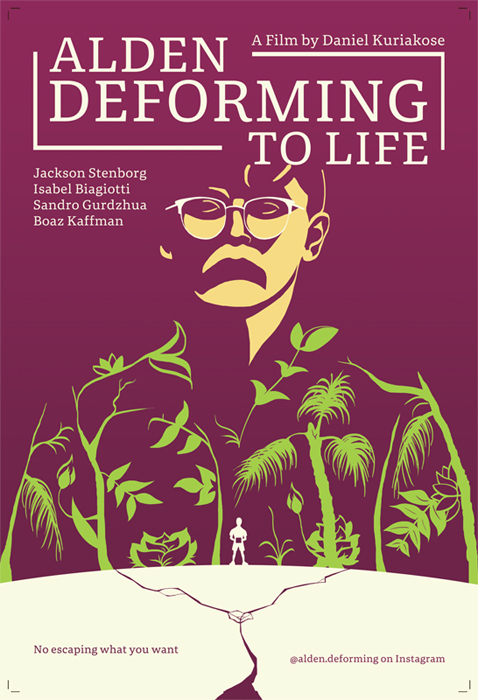
Daniel Kuriakose - Poet & Filmmaker
"Alden Deforming to Life" on INSTAGRAM
Trailer of 45 minute film , directed by Daniel Kuriakose, a 2021 Graduate of SUNY Purchase
click here for an individually printable page of this review
a 2022 film written and directed by Daniel Kuriakose dkhime.kuriakose7@gmail.com
Kuriakose's film is a surreal and existential story, with cinemagraphic methodology and innovative non-linear techniques that Mr. Kuriakose employs on several significant levels: In the beginning scene, a young man named Ben sits alone at a table in a cafe diner, the waitress sits on the floor nearby taking his order. Ben then encounters a childhood friend Jared with whom he updates personal news of the time since childhood. Ben speaks of his recent marriage.
Then, while Jared goes to the counter to order coffee, Ben is visually transported alone to a paved path in a large park, where he encounters an unknown
young man who is holding a baseball bat. This meeting quickly escalates into a deadly encounter, where Ben is bludgeoned. The killer strips Ben of his Hawaiian-floral shirt and puts it on himself, and next visits Ben's home and rings the doorbell. Ben's pretty wife Mia answers the door with apparent recognition. “I'm home,” he says. “I can see that,” she replies, then reluctantly, and somewhat furtively, invites him in for something to eat. This is Alden. Sitting across a wide glass kitchen table, Alden, dressed in Ben's fancy shirt, seems to expect Mia to accept him, but she says, “You're not my husband...” to which Alden answers repeatedly, “I killed him… He's dead. I killed him.”
I relate this not meaning to be a plot-spoiler, but as this scene is really the jumping-off point of this surrealist story -- especially as Ben is next transported alive back from the park to his seat in the diner! There must be something more to this situation, as Mia admonishes Alden, "It's not your fault..." -- Were these surreal hours of confrontation between Ben and Alden, the existential sense of Ben's murder, and Alden's visit to Mia, a fantasy or a premonition?
On a level of dialog, the initial table discussion of Ben and Jared sets the stage and addresses issues -- social issues – of individual recognition of creativity and technique, and issues of mortality in the community. The news of the discovery of a mysterious body under a nearby recreation site, a bowling alley in this case, defines these apparent tangents in the story as expositions and clues to the way events are about to unfold in the abstract dimension of Time, past vs. future, murder vs. acceptance, life vs. death. In the dialog, the film's continuity explores the existence and dilemmas of ambiguity in the premonition of pending actions of dominance and violence, and the problems of equivocation in terms of how each person (each character) interprets and understands immediately recent behaviors and events. This is a kind of Everyman story.
In this production, director Daniel Kurikose's techniques utilize horizontal parallel masking bars in order to develop the surrealist presentation of the film itself, that is: obscuring obvious aspects of pending actions, also pointing up the separation between the viewer and the movie screen, the separation between perpetrators and victims, and the unclear separation between future and past events. This is a unique twist on the principle of “suspension of belief” that must take place in any film, television show, or in reading a book. In every case, in this production, the timing, the direction, the familiarity and arch-typicality of settings, and the professional talents of each actor, all work to create a successful film. Especially notable for their acting talents are the cool demeanor of Isabel Biagiotti as Mia, the experiential awareness of Sandro Gurdzhua as Ben, and the personal determination and the transformation-(and Deformation)-in-progress of Jackson Stenborg as Alden.
~ review by Johnes Ruta 22 March 2022
independent curator and art theorist
https://AzothGallery.com/
azothgallery@comcast.net
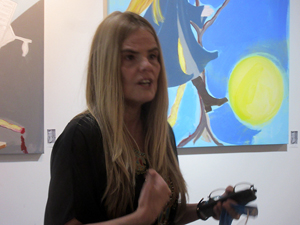 |
|
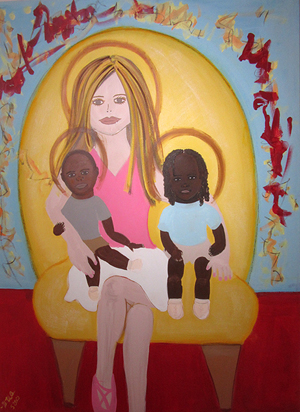 |
|
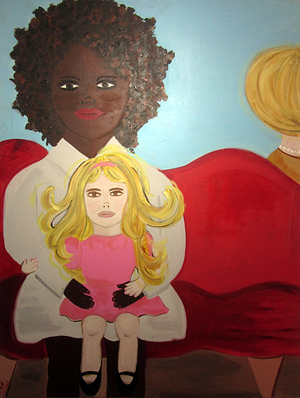 |
 |
||
********************************************************************************************************************************
ART
REVIEW:
"In Praise of Color" a 3-person Artist Exhibit Compliments
the Range of Chromatic Harmonies
artworks
by three artists in the December art show at River Street Gallery, Fairhaven
Furniture,
East Street, New Haven, CT:
Lexi Axon, Marissa Tadei, Fethi Meghelli -- exhibit on view through
January 13, 2019.
The artworks of the
three artists in the present art show at Fairhaven Furniture would be
appropriate for holiday gift giving, especially as most of these
works display the kind of aesthetic energies that would compliment the
furnishings of any home, modest to extraordinary. This is well-accented
by the
elegant presentation of these artworks, the framing and scales of sizes,
and skillfully curated by Liz Pagano and Kate Paranteau in the upscale
showroom.
BUT -- looking closer, the aesthetics in these three distinct styles of
painting betrays qualities that delve much deeper than decoration. There
is indeed
an overall harmony of chromatic energies, though the individuality of
each artist is distinctly stated.
The broad wide strokes
of color in Lexi Axon's large etchings, especially the brightness of red,
manifest the Abstract Expressionist kind of statement,
but Ms. Axon takes the historical reference to a vastly further point
of view, to a hypnotic slow-motion kind of turn into the whirlpool of
intensity
and the trance of red ! These pieces are at once profoundly intellectual,
decorative, and mesmerizing. This is the kind of abstraction in painting
that opens a door into the unconscious of its presence, that if displayed
prominently in the home, would transform over time, like a large scale
kaleidoscope. Indeed, the exhibition preview describes these in terms
of "fiery reds and pinks that tilt and twist expressively."
Right!
In a complimentary
sensation, Marisa Taddei's monotypes made with handmade paper and collage,
have an altogether distinct density.
The crowded, curved, and compressed vertical lines, some create sensations
of adjacent sections of surface in vertical threads of color,
some with imbedded window frames and diagrammed hued clouds, some parallel
lines which run toward obstructed perspective.
While in a wide range of color, observe a specific earthiness of hue:
reds, browns, yellows, light blue, and greens. The earthiness
of color tones convey a panorama of naturalism, an presence of Nature
herself in the woven textures and motions of growth emerging.
Fethi Meghelli's
monoprints work with figurative characterizations inherently within medieval
or overly-simplified landscapes, and exotic
constructions of souks and agora, market-places. "Warmer Nights"
and "A River and A Tree" are experiential, happening in slow-motion.
Each figure in motion seems to have a story to tell from their individual
positions and postures. The situations are implied and subtly
emotive, or vacant. There is a texture of things that happen in real-life,
then a warmth of energy and figure in Meghelli's rich mixed-media
colors, oil stick surfaces and monoprint inks. The work is accomplished
in skill and subtle but reminding storytelling: immigration, musicians,
women in long dresses, boats on the water, an airplane in flames -- time,
and space, stand still, waiting to be seen.
art theorist
New Haven
azothgallery@comcast.net
Curated by Liz Pagano
and Kate Paranteau, In Praise of Color features a vivid collection of
paintings and prints that embrace the festivity of the holiday season.
Diverse and playful applications of color and texture lead the viewer
on a journey that invokes a sense of wonder and piques the imagination.
Working
with raw pigments and etching, Lexi Axon blends the swirling growth patterns
of seeds with fiery reds and pinks that tilt and twist expressively.
The prints
and collages of Fethi Meghelli weave tales of people, migration and commemoration
with deep shades of turquoise and blue.
Marisa Taddei
combines monotype prints with handmade papers and collage into multi-colored
and layered vistas, suggesting jubilant metaphors of nature.
**********************************************************************************************************************************
http://azothgallery.com/2018-05_DaSilva_Pablo-Amaringo.htm
CURRENT ART EXHIBIT AT THE DASILVA GALLERY OFFERS PROFOUND ENCOUNTERS WITH ART & THE MYSTICAL STATES OF THE PERUVIAN SHAMANS
When you unite the talents and experience of three eminently qualified professionals -- a first-rate art curator, a worldly and well-seasoned professor and a highly regarded local gallery owner -- you almost always come up with an art show that simply cannot be missed. Such is the art show on Peruvian shamanism presently on exhibit at the locally famed DaSilva Gallery in New Haven's Westville section thanks to the efforts of well-respected art curator Johnes Ruta.
Until May 31, 2018, the show entitled "The Magical Mystery of Shamanism" will festure the magnificent works of the late vegetalista curandero of the mestizo tradition, Pablo Amaringo, who passed in 2009, and his students. Amaringo and the students of Amaringo's Usko-Ayar school of painting created these visionary artworks from their experiences deep in the rainforest of Peru after ingesting ayahuasca, an entheogenic concoction comprised of plant derivatives.
At the Gallery's opening, the collection's owner, Scott Olsen, Professor Emeritus at the College of Central Florida, Ocala, who is well-versed and well-experienced in the ways of the ayahuasceros asserted that this concoction is "the fastest way to die to the ego." He explained that ingestion of ayahuasca really is a "dry run at death" as one attains supernormal perception allowing for profound encounters with plants, animals and ultimately, the Logos.
Upon viewing these incredible artworks, there seems to be no question that these deep mystical states are precisely what Amaringo and his students have in fact experienced during their vision quests. Central to the exhibit is Pablo Amaringo's painting, "Curved Knowledge," which invites the viewer to follow a serpentine path that ascends in both knowledge and divinity. At the bottoms of the painting, we watch as retreat participants are depicted ingesting ayahuasca or having its smoke blown into the palm of their hands or on the nape of the neck by other retreat participants. Then the visual odysseys begin as we first encounter animals and plants and then our eyes rise to meet ascended masters, diving beings and even sacred geometric forms at the painting's top.
And without eschewing the importance of the artistic and culturally iconic masterpiece that "Curved Knowedge" clearly is, each and every painting of Amaringo's students depicted in the exhibit are visionary masterpieces of their own. The purples, blues, greens, reds, oranges and yellows in all of these paintings are just so saturated that to view these paintings offers an experience with synesthesia. For no longer do you only "see" the rich colors but you and I can actually "feel" and "hear" the colors as they vibrate with unrelenting intensity. Spirit animals like the owl, the eagle, the cheetah and especially, the jaguar are common in these paintings as is the lush vegetation of the Peruvian rainforest.
Indeed, visionary paintings such as these are not typically found on the walls of most museums in the Western hemisphere. And according to Professor Olsen, the reason rests primarily in the fact that most of Western civilization is immersed in a dark and destructive energy that is pulling us from nature and our innate divinity. Far from being protectors of "Mother" nature, Western civilization has cast itself far afield of the Divine Feminine. Most of the populations of the Western hemisphere have become saboteurs of this beautiful planet and in losing our relationship with "Mother" nature we have virtually lost our connection to what the plants and animals can teach us about attaining the Logos.
Perhaps, there is no wonder that even in Christian societies most apparitions of the Logos (Jesus) and Divine beings such as the Virgin Mary manifest primarily amidst simple, indigenous and agrarian populations where there remains an intimate and enduring relationship with nature. The apparitions of the Virgin Mary in Fatima, Portugal to the shepherd children, Francisco and Jacinta Marto and their cousin, Lucia Santos, are prime examples.
Undoubtedly, there is much to the belief that there is no way to the Father/the Son but through the Mother. And yet, according to Professor Olsen, the rigors of pursuing an ayahuasca retreat are many. Not only is the Peruvian rainforest far removed from the usual comforts of civilization but the average Westerner would probably be ill-advised to even entertain the possibility of such a journey. Professor Olsen advised that the ayahuasceros require a diet of extreme physical and sensual deprivations in order to prepare the body for such a profound activation of the third eye chakra.
But, a short trip to the DaSilva Gallery is certainly in order where you can enter a meditative state just by fixating on one of these magnificent artworks. Enter by the jaguar's mouth, the mouth of the cheetah or the headwaters of the Amazon. You won't be disppointed.
Authored by Donna
Marie Joyce Copyright 2018
By Alan Bisbort
Alan Bisbort is a
writer, editor, and researcher who has authored or coauthored sixteen
books of art, history, music, and travel and contributed to numerous other
books. His work has appeared in the New York Times, Washington Post, Rolling
Stone, In These Times, Los Angeles Times, Hartford Advocate, and many
other publications.
What would one expect from artwork created deep in the Peruvian rain forest,
awash in the sounds of the Amazon River headwaters? And when the artist,
Pablo Cesar Amaringo Shuna (1938-2009), was also a shaman whose work was
inspired by visions arising from ayahuasca, a plant brew that similarly
dispatched Carlos Castaneda to the furthest corners of the human mind,
the art is bound to be, at the very least, verdant and colorful.
Still, little can prepare viewers for the work that will appear at the Da Silva Gallery in New Haven in May 2018, from Scott Olsen’s collection of paintings and prints by Amaringo and the students of his Usko-Ayar School of Painting, such as Felix Pinchi Aguirre, Alfredo Zagaceta Cometivos, Jorge Enrique Ramirez Flores, Ener Fias Nunez and Ruisen Flores. Olsen, a University of Florida philosophy professor, spent nearly two decades traveling to the rain forest and Amazon headwaters of Peru to explore this art and the shamanic tradition that inspired it. He is the author of Mysteries of the Amazon: Visionary Artwork of Pablo Amaringo and his Students, which offers a visual sampling as well as a chronicle of his trips to the Incan strongholds in Peru.
Take “Conocimientos Curvos (Curved Knowledge)”, which Amaringo painted in 2003. With Bosch-like detail and a palette that redefines what greens and blues can do on a canvas, the artist creates a multidimensional universe that embraces the spirits that vision masters like Amaringo find in the rain forest. Even when the meaning of the work is not immediately (if ever) knowable, the viewer simply cannot take his eyes off of it. Not to trivialize the work, but it is this quality that renders much of the psychedelic art of the 1960s so timeless. The power of the images are just as strong now, 40 and 50 years later, that they were at the time of their creation. They are—like the work of Amaringo and his disciples—not affixed to any artistic school or trend. They just are.
The same sense of timelessness can be seen in “Allpa Runa (Underground
Earth Spirits)” which, according to Olsen, is the “spirit genii
who live in the tunnels, the catacombs, subterranean holes, caves, grottoes,
and beneath the cemeteries and cavities of the earthly globe.” Yes,
it may be all of those things, but it is also a stunning visual feast
the likes of which one can find the equal of in only the finest of Persian
or Hindu art. The fact that this painting was completed on September 12,
2001—the artist no doubt oblivious to the tragic events in New York
and Washington D.C. the day before—is enough evidence, at least for
this viewer, to suggest that forces beyond our understanding are shaping
the world we live in.
Exhibition May
11 - May 31, 2018.
Reception: Friday, May 11, 6 to 8 PM
Curated by Johnes Ruta 203-387-4933 azothgallery@comcast.net
DaSilva Gallery Fine Art and Framing
897-899 Whalley Avenue New Haven, CT 06515
203 387 2539
essay by artist Jonathan Wilner
Near the entrance of one of the rooms at Museo des Bellas Artes in Seville, I espied a painting of cacti in full bloom. Instantly I recognized the artist only to confirm it by looking at the plaque which in Spanish and English briefly explained that this was a painting by Jose Arpa. Hastily, I pointed this painting out to a Frenchman who gave it a glance only to focus on the other paintings. He scoffed at the very notion that this was Texas and that such a large state was actually the same size as France. He was not amused and due to my enthusiasm for this painter, he thought me to be a Texan. Our conversation gravitated towards politics. He found our presidential politics simply amusing, And when I quipped but you guys love Jerry Lewis, he fervently agreed. For some reason the French simply adored this comedian. I wonder why. What did they see in him? Anyway I retorted that our presidential politics for me was a sad affair.
A moment later I heard in English his ecstatic ejaculations over Arpa's landscape. I triumphantly pointed out to him once again that this Spanish painter was adopted by us Americans as our very own and that was especially true forTexans. And I reiterated that though I am not one of them, I had at one time lived in that fair state. He conceded that this painting was indeed remarkable but boasted about the beauty of southern France. Perhaps one day, I too will have the privilege of seeing LangueDoc (pronounced long doy) and other parts of Provence. We parted company after I emphasized the beauty of the Hill Country when the bluebonnets and Indian paintbrush dot the countryside. He expressed no intention of ever visiting Texas.
And now to Jose Arpa y Perea: Born in Carmona, he studied at Seville's Academia des Bellas Artes under Eduardo Cano de la Peña. As three time winner of the Rome prize, he was allowed him to study there for a total of six years. In 1893, three of his paintings were sent to the Chicago World's Fair (World Columbian Exhibition). As a consequence, he was offered a position as director of Mexico City's Academy of Fine Arts which he declined but stayed in Mexico. Eventually he ventured northward to San Antonio where he tarried for some years exerting a positive influence on another Texas regional painter Porfirio Salinas. His moniker, “The Sunshine Man” is apt when looking at the cacti in bloom in that painting in Museo des Bellas Artes showing evidence of his adroitness in the use of brilliant colors and his painterly style vivid but fluid exuding the confidence of a well trained and experienced painter.
Among the prizes that this prominent landscape artist won was one in 1927 for the amount of $1,000 granted by the San Antonio Art League which still possesses his award winning oil entitled “Verbena.” He traveled between Mexico and San Antonia eventually establishing a school in 1923. With his nephew, Xavier Gonzales, whom he had taught, they conducted plein air classes in Bandera, Texas. Shortly thereafter in 1931, Arpa returned to Seville, Spain remaining in his native country until his death in 1952 at the age of ninety-four.
Let's look into the instructor who may have been his greatest influence, Eduardo Cano de la Peña: Born in Madrid, his family had moved south to Seville. His father had become that city's chief architect which in all probability was a formidable role given the abundance of old structures perhaps some in disrepair. The question would have been for that time to build new structures which would blend in with the dominant architectural forms. I suspect that even in the 1800s, the city's denizens did not want to lose the identity of their home to modernity. What challenges that Cano's father encountered in this ancient city is worth an essay in itself. However, I will leave that to the architectural history buffs here.
Upon his father's death Cano returned to Madrid where he studied in the academy of one of Spain's foremost historical painters Federico de Madrazo and then later on to Paris. He returned to Seville as the chief curator and a professor of its art school/museum. It would seem that he imparted to Arpa a feel for painting, color theory, and composition. Although his focus was on personages both religious and historical, Arpa's focus became that of nature and human habitation – a combination of both landscapes and genre paintings the subject matter of Impressionism. Art historians classify his teacher's work as part of Romanticism while the student Arpa is classified as Impressionism.
Down the line of disciplic succession we come to one of Arpa's foremost students, Porfirio Salinas, who was one of the earliest nationally recognized Mexican-American painters. Born to a family of tenant farmers who left the fields for San Antonio, Salinas had little formal education but showed an interest in drawing at a young age. Having to earn his keep, he went to work at an arts supply store where he met the English landscape painter Robert William Wood and went to work at his studio where he learned about stretching canvas, mixing pigments, and the marketing of artwork. He traveled with Wood and Jose Arpa into the countryside to sketch. By 1930 a year before Arpa returned to Spain, Salinas became a professional painter. He finally achieved national acclaim when President Johnson publicly regarded him as his favorite artist decorating the White House with his scenes of Bluebonnets and other views of the Hill Country. The White House collection permanently resides at the LBJ ranch.
Thus we have seen three generations of artists forming a link through Jose Arpa from the old world to the new bridging two continents Europe and North America. From the Romanticism of Cano to the Impressionism of Arpa and Salinas both beloved regional painters of the Texas Hill Country though the former artist returned to his birthplace.
Here are a couple of sources to browse:
http://www.saalm.org/arpa.htmlhttp://panhandleplains.org/gallery.asp?pageid=7&galid=481
http://www.painting-history.com/artist/cano_eduardo.htm
Jonathan Wilner
To identify the historical paintings; the spiritual connotations of color in light, pigments, and crystals.)
Welcoming comments and thoughts on the associations of spectral colors...
from
Johnes Ruta
Independent Curator & Art Theorist http://AzothGallery.com/
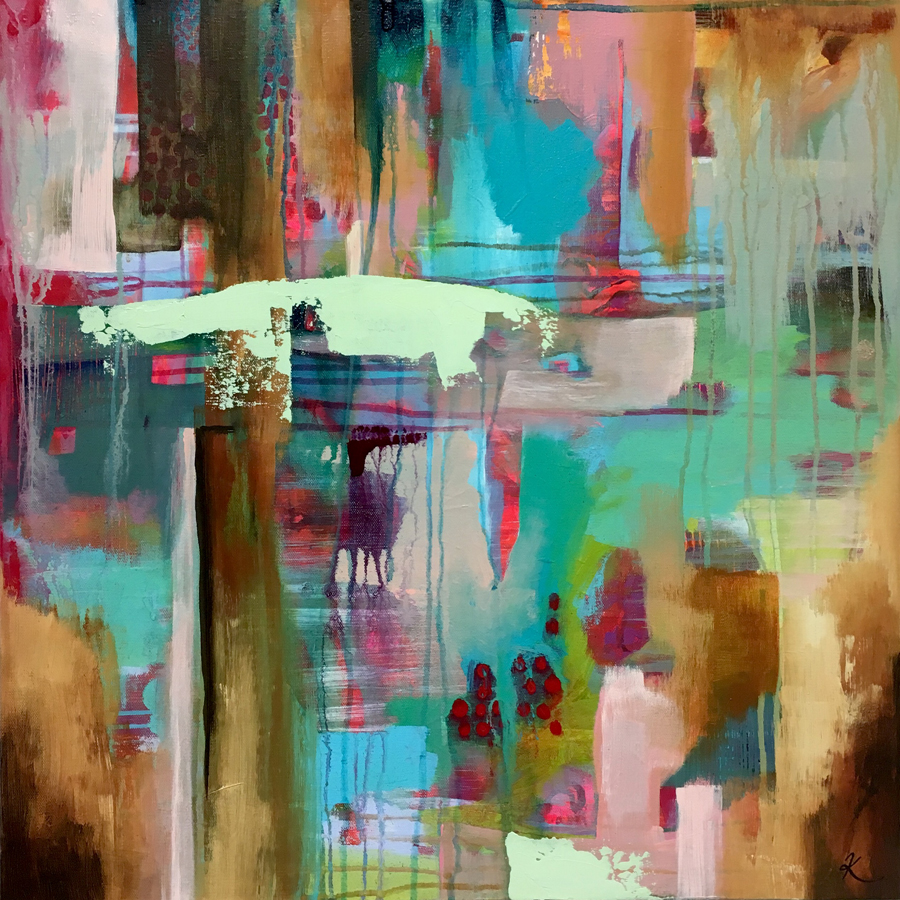
Kristen Ambrosi "Familial" acrylics on canvas 24" 24"
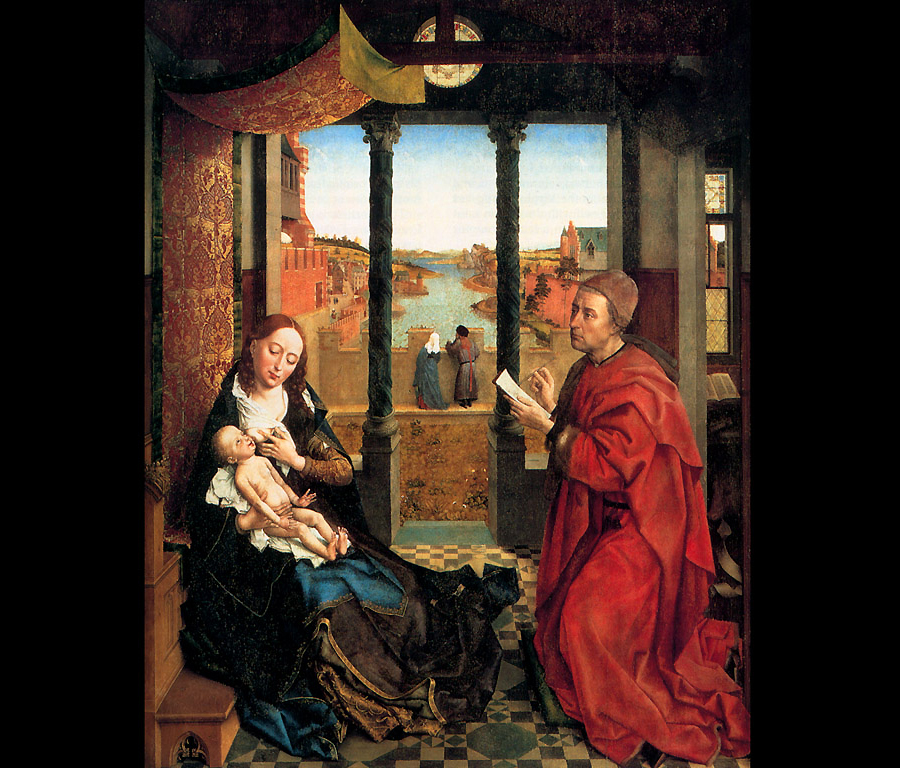
Rogier van der Weyden "St. Luke Drawing the Virgin" 1435-38
oil on panel, 54" x 43", Boston Fine Arts Museum
Rogier van der Weyden (Dutch: 1399 or 1400 – 18 June 1464) Early Netherlandish painter whose surviving works consist mainly of religious triptychs, altarpieces and commissioned single and diptych portraits. Internationally famous in his lifetime; his paintings were exported to Italy and Spain, and he received commissions from Netherlandish nobility, and foreign princes. He is known, after Robert Campin and van Eyck, as the third great Vlaamse Primitieven ("Flemish Primitives"), and as the most influential Northern painter of the 15th century.
Karel van Mander wrote that the great artistic contribution of Rogier van der Weyden lies in his ideas, his composition and rendering of the soul's expression through pain, happiness or anger, and the tempering of this emotional testimony to the subject matter of his work.
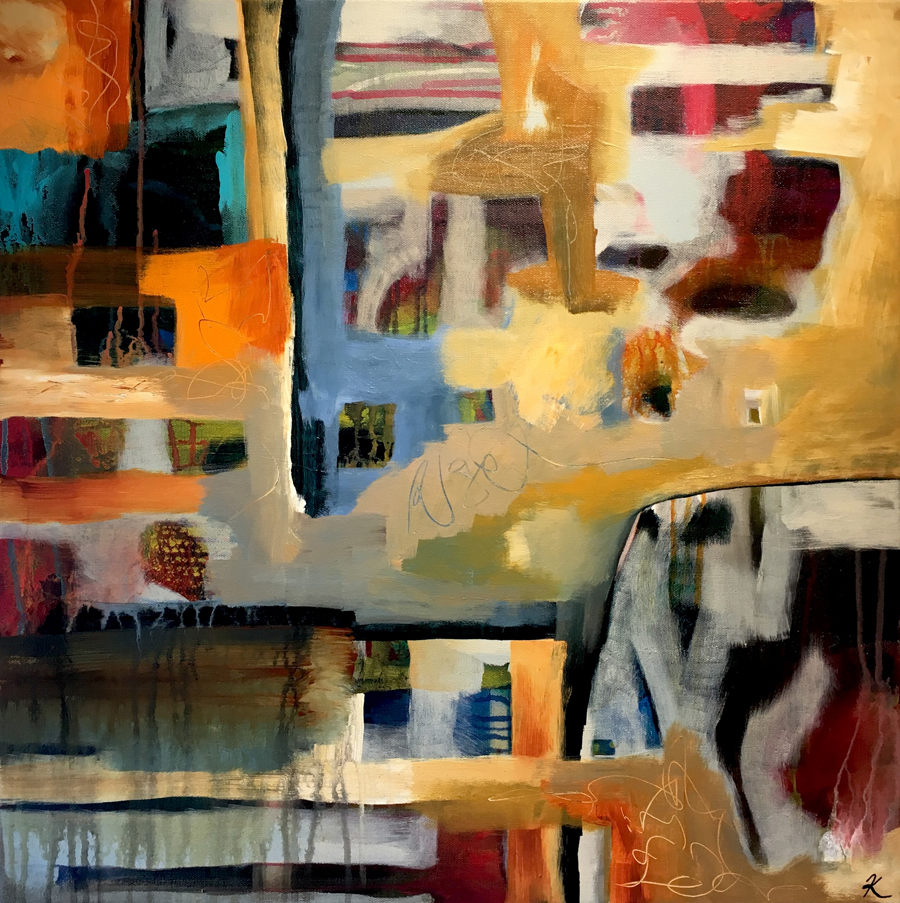
Kristen Ambrosi "Paths" acrylics on canvas 24" 24"
"Inspired
by light, color, nature, music, and words, this work is an evolving exploration
of the beauty within these elements, gathered and channeled into two dimensions.
The fundamental goal is to create harmonious canvases that resonate and
vibrate, embracing the richness of human experience through the use of
exquisite color, light, and form. As a practitioner and instructor of
yoga, the themes are: balance and integration. I repeatedly rotate the
canvas in a composition where the weight of color and contrast feel balanced.
Intuitive abstractions emerge through layering. "Metaphors
for life, such as facing the unknown with courage, surrendering the outcome
guided by the heart Less representational imagery and more broad forms
follow intuition about what comes next. It is a bold, scary, trusting,
and exciting place from which to be working, with the hope that my paintings
reflect the truth of that energy."
~ Kristen Ambrosi
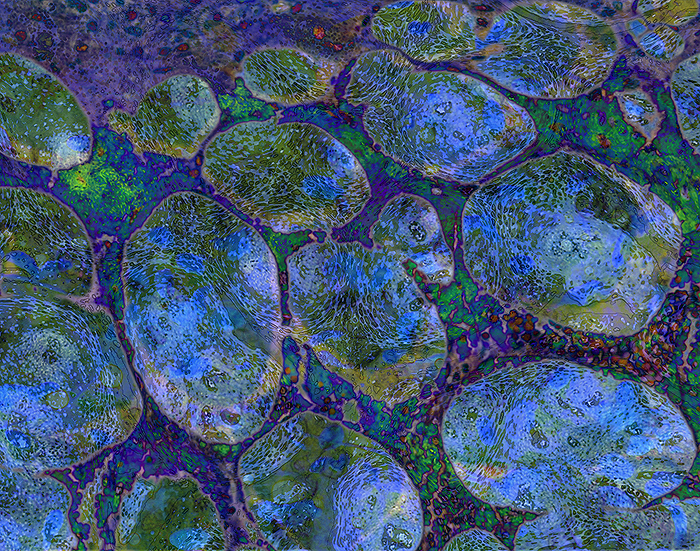
Kate Henderson
"Monet Stones" - Cyto-print archival digital print 24"
x 30"
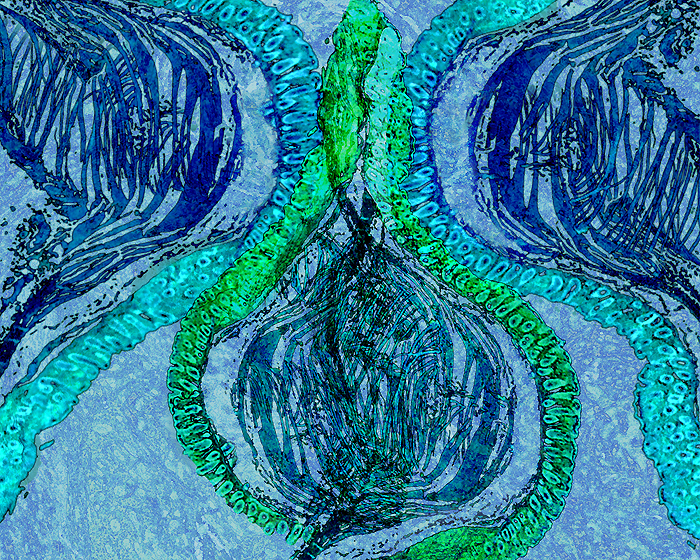
Kate Henderson "Onion Heart" - Cyto-print archival digital print
24" x 30"
On
a biological level we are echoes of the past regeneration and evolution.
We each have a unique energy, that connects us to
each other yet we are all structurally made of the same biomorphic mesh.
~ Kate Henderson

Jaochim Patinir "Landscape with Charon Crossing the River Styx"
c.1510 oil on panel 15 x 40 -- El Prado, Madrid
Joachim
Patinir (c. 1480 – 5 October 1524), was a Flemish Renaissance painter
of history and landscape subjects. He was from Wallonia (southern modern
Belgium). He worked in Antwerp, at that time, the centre of the art market
in the Low Countries. Patinir was a pioneer of landscape as an independent
genre and effectively invented the distinct style called world landscape,
as panoramic Northern Renaissance landscape, an important development
in Northern and Italian art.
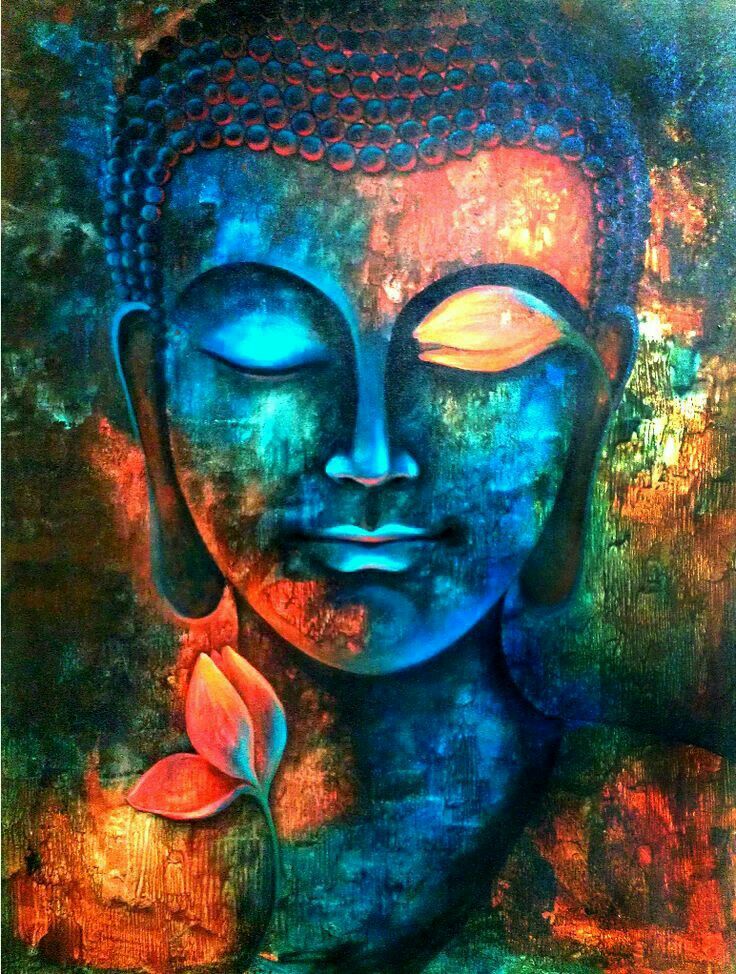

Jan van Eyck "Madonna of Chancellor Rolin" oil on panel, c.
1435. 66cm x 62cm. Musée du Louvre, Paris
Jan van Eyck (Dutch: before c. 1390 – 9 July 1441) was an Early Netherlandish painter active in Bruges. He is often considered one of the founders of Early Netherlandish painting, and, one of the most significant representatives of Northern Renaissance art. The few surviving records of his early life indicate that he was born c. 1380–1390, most likely in Maaseik. He took employment in the Hague as painter and Valet de chambre with John III the Pitiless, ruler of Holland and Hainaut in the Hague around 1422, when he was already a master painter with workshop assistants.
** The discussion of the spiritual connotations of color.
** Rogier van der Weyden, Jan van Eyck, and Joachim Patinir texts are
excerpts from Wikipedia articles.
from
Johnes Ruta
Independent Curator & Art Theorist
http://AzothGallery.com/
BEING
* dynamic dimension
/ static dimension
* the evolution and shaping of Consciousness
essay outline by
Johnes Ruta, 2017. (a work in progress)
Johnes busy working like a bee: BEE-ING "I bee, therefore I buzz."
Quintessence: a
fifth element following,
FIRE AIR WATER EARTH,
The Quintessence is a combination of Gold and Light.
Veda -- Atman =
Absolute Being
Shiva = Total Destruction = Non-Being
Krisna = There is no Non-Being. " Nothing that exists can be destroyed,"
(Bhagavad Gita, 5th to 2nd century BCE).
Mohenjo Daru, Indus Valley -- Material Geometry of the world. Patterns of the mineral kingdom.
Sumer -- Entity
of the VOID (Ti'amat)
---> Hebrew: "Tehom" = Genesis: 1:1 -- the Light reflected
on the waters of the Deep.
---> Greek "Thalassate" = the sea.
Egypt -- NUN --
the Creation = the DARK WATERS of CHAOS (derivative or parallel of Ti'amat?)
the HYPOSTASES - the massive manifestation of MASS.
Hesiod -- c. 750
- 650 BCE.
Muthos -- "the world comes from Nothing."
Thales of Miletus
-- c. 624 -546 BCE.
WATER = as the Primary Component of the Universe.
Liquiform consciousness identified.
Pythagoras of Samos
-- 570 - 495 BCE.
The Geometry of time and space, the four cardinal points.
indefinite metempsychosis (reincarnation)
Heraclitus -- 535
- 475 BCE.
FIRE -- ignition and combustion of the Universe. Fire is the Primary Component
of the Universe.
Parmenides of Elea
-- 515 - after 450 BCE.
- BEING
- Being is.
- Non-Being is. (Non-Being cannot be realized, except as an idea that
totally destroys all other ideas.)
- Being and Non-Being are.
BEING is the only rational solution.
Democritus -- 460
- 370 BCE
the atomic theory of the universe -- matter is divisible into its smallest
parts
Void theory -- motion as established by Becoming (Being in motion) requires
an antithesis, the Void.
Epistemology = the knowledge of "truth" is subjective according
to the individuality of personal senses.
Empedocles of Akragas
(Agrigento, Sicily) -- 490 - 430 BCE.
Reconciliation of Being and Becoming.
Matter is composed of 4 elements: Fire, Air, Water, Earth.
Primary forces of the Universe are "Love" (attraction) and "Strife"
(repulsion)
-- Variations consist of combinations of Harmony and Discord.
Aeschylus -- 525
- 456 BCE
Sophocles -- 497 - 405 BCE
Euripides -- 480 - 406 BCE
The Human Tragedy of Being and the Unexpected
Aristophanes --
446 - 386 BCE
The Thieriomorphic Comedy of Being
Aristarchus of
Samos -- 310 - 230 BCE.
Heliocentrism -- the Sun being the center of the solar system of planets.
Plato -- 427/423
- 327 BCE
Solid Geometry of 3-dimensional Forms. Platonic Forms.
The Monad of divinity.
The Kabbalah --
5th century BCE
000. Ayin (Nothing)
00. Ein Sof (Limitlessness)
0. Ohr Ein Sof (Endless Light)
-.Tzimtzum (Contraction)
Keter (Crown)
Chokhmah (Wisdom)
Binah (Understanding)
Chesed or Gedulah (Loving Kindness or Mercy)
Gevurah or Din (Power or Judgement)
Tiferet (Beauty or Compassion)
Netzach (Triumph or Endurance)
Hod (Majesty or Splendor)
Yesod (Foundation)
Malchut (Realm)
Gnosticism -- 500
BCE - 325 CE
the HYPOSTASIS of the Archons (Time/Space entities)
Valentinus -- 100 - 150 CE
Sophia and Hermes
the PLEROMA (Fullness of the Universe) = Being
the KENOMA (Emptiness of the Universe) = Non-Being
Jesus of Nazareth
-- 4 BCE -31 CE
The Being of Compassion
The Being of Tolearance
The Being of Peace
Claudius Ptolemy
of Alexandria -- c 100 - c 168 or 170 CE
The Almagest
Geography of the geocentric dimension
Boethius -- 480
- 524 CE
Sophos -- the divine Wisdom of Being
Augustine of Hippo
-- 354 - 430 CE
The City of God
Dante Algehieri
-- 1265 - 1321 CE
The devotion of Being and Love
The inverted pyramid of sin
The pyramidic mountain of Reconciliation
The hierarchic pyramid of Virtue
The supreme position and being of the Absolute.
Alchemy & the Hermetic Tradition -- ? 1000 BCE - 1700 CE
metaphor, manipulation, transmutation.
materiality as Essence, elements, and stasis.
GOLD as the Purity of Essence.
the four Humours: Dry and Wet, Hot and Cold.
the three trans-mutational components of Mercury, Sulfur, and Salt.
Copernicus -- 1473
- 1543
the heliocentric solar system
mechanistic motions of the Cosmos.
view of the physical sky above in 3 dimensions
Leonardo -- 1452
- 1519
FUTURE time in Vision --> design in natural media
(wood interpreted future mechanism .. time view in sepia.
Paracelsus -- c.1493
- 1541
iatrochemistry -- the metabolic inner dimension of interaction
Giordano Bruno
-- 1547 - 1600
the Hermetic COSMOS = Mysterium
Johannes Kepler
- 1571 - 1630
mathematical application of elliptical orbitation and spatial vortical
velocities
the Harmony of all the Spheres (musical relationships)
Jacob Boehme --
1575 - 1624
The AZOTH is the Quintessence, the combination of Gold and Light.
Sir Francis Bacon
--
rejection of the Aristotelian total categorization of phenomena and knowledge
initialization of the Experimental Method with the uses of optical devices
of the telescope and microscope.
William Shakespeare
-- 1564 - 1516
word & verses of the (Pleroma) Fullness of Life Energy.
"To Be or Not to Be ?"
The dichotomy of Guilt and existence.
Johannes Kepler
-- 1571 - 1630
revealed the Mathematical Perfection in orbital forms
in Solar and Galactic open Space.
Descartes -- 1595
- 1650
BEING = cogito ergo sum
Question of the Infallibility of the Divine God -- manifesting
the UNFOLDING of REALITY (the Reality of Current History as experience
-- back to the Emperical model ?µpe???a, empeiria
Vortical fields of time and space
The Theory of the
Baroque -- 1600 - 1750
the Romantic Ideal of DYNAMISM
phenomenon of the "Modern"
harmonic structure and pattern of music
the CONTINUO of music -- the underlying base line of Time/Space ( --->
Time-Line theory of Einstein)
Thomas Hobbes -- 1588 - 1679
The LEVIATHAN (Ti'amat) as the Body of History -- the Commonweal of Mankind.
The Absolute of Monarchy
Isaac Newton --
1642 -1726
visualized and proved the mathematical model ("Fluxions" i.e.
calculus)
Gravity = attraction to the object (cf. Empedocles)
finite division of the spectrum of light
Gottfried Wilhelm
von Leibniz -- 1546 - 1716
the CALCULUS of Time and Space (i.e. "Fluxions")
the Platonic MONAD as the Hypostasis singularity.
John Locke --
1632 - 1704
contra Hobbes
Rationalist Construction
of Society in government and Absolute Principle as Justice in terms of
the Human Mind and human perception.
Recognition of our own human experience in context of Justice for Humanity.
Enlightenment principle of "the greatest good for the greatest number."
David Hume and Thomas Reid confirmed and built on this Argument for the progress of the Dialectic.
George Berkeley
-- 1683 - 1753
The SOLIPCISM of Emperical Being (the moral equivalent of class privilege)
Immanuel Kant --
1724 - 1804
The critique of Being
The Categorical Imperative of Life
Georg Frederick
Hegel -- 1770 - 1831
Consciousness
Absolute Idealism
Alienation
Abstract Particularity vs. Concreteness
Geist = mind/spirit
The Phenomenology of the Dialectic -- Universality, Particularity, Individuality.
Charles Darwin -- 1809 - 1882
the Evolution, adaptation, and survival of diverse animal species
the human Being as a member of Animal Kingdom
Eugène Delacroix
-- 1798 1863
Charles Baudelaire -- 1821 - 1867
The Avant-Garde of Creative Reality
Georg Friedrich
Nietzsche -- 1844 - 1900
The Apollonian vs. Dionysian
The Birth of Tragedy
Max Planck -- 1856 - 1947
Quantum Theory = specific vibrations of material elements of Matter
Georg Groddeck
-- 1866 - 1934
The IT = the "Id" = primal forces and emotion
Sigmund Freud --
1856 - 1939
Being in society
Id (instinct), Ego (personality), SuperEgo (conscience)
The experience of the Oceanic (Civilization and its Discontents)
Carl Jung -- 1875
- 1961
Cosmic Consciousness
Synchronicity
Mysteruim Coniuntionis
Alfred Korzybski
-- 1879 - 1950
Semantics -- Science and Sanity
Consciousness of Abstracting
Predication: "is" (to be):
"the is of identity"
"the is of predication" (is = from subject to object)
Albert Einstein
-- 1879 - 1955
Energy = Matter x Speed of Light x Speed of Light
Energy = the potential for a particle to change position
The Relativity of Space / Time
The Curvature of Space
Time-Lines of moments in Relative Space
Atomic Fission
the Fusion of Hydrogen atoms = energy
Werner Heisenberg
-- 1901 - 1976
the Uncertainty Principle of object motions
Albert Schweitzer
-- 1875 -1965
The Being of Compassion and Harmony
Martin Heidegger -- 1889 - 1956
The Grammar of Being -- "das sein" = "Being there"
Jean-Paul Sartre
-- 1905 - 1980
Being and Nothingness -- the Existential Dilemma of Being and Responsibility
Experiential Being
Being in modern society...
Abraham Maslow
-- 1908 - 1970
Being-Cognition
Deficiency-Cognition
Self-Actualization
Peak Experience phenomena
John Cage -- 1912
- 1992
Andy Warhol -- 1928 - 1987
The Be-In -- the experiential Being of togetherness
Aldous Huxley --
1894 - 1963
Timothy Leary -- 1920 - 1996
Ram Dass -- b, 1931
Cosmic Consciousness Utopia
Jorge Luis Borges
-- 1889 - 1986
The Aleph = the Totality of the universe
Cleve Backster
-- 1924 -2013
Plant Consciousness (measured with polygraphy)
Rupert Sheldrake
-- b. 1942
the growth and metabolic communication principles of Morphic Resonance
Richard Feynman -- 1918 - 1988
Gauge Theories = physical model of the interactions of universal forces
Feynman Diagrams = pictorial representations of the mathematical expressions
describing the behavior of subatomic particles.
Steve Weinberg
-- b. 1933
Abdus Salam -- 1926 - 1996
the Weak Force - "the cosmic alchemist"
Electro-Weak Theory
3-Quark Theory = 2 hyper-microcosmic sub-nuclear particles connected by
a super-heated Gluon.
Strange Particles: J or Psi
Charmed Particles
String Theory (not mathematically productive, but related to the Gluon as the Quark "string" connecting two Quarks)
Dark Matter --
qualifies missing Mass of the known Universe).
Dark Energy -- qualifies missing Energy of the known Universe).
Peter Higgs --
b 1929
the Higgs Boson -- proof of the Gluon particle.
Brian Greene --
b. 1963
discovery of the Quilted Multi-Universe = indefinite Big Bangs in hyper-distant
limitless SPACE
Multi-Universal simultaneous Consciousness
Thought as immediate universal communication.
the replication of concurrent Realities in detail
Johnes Ruta -- b. 1947
the theory of Prolepsis (the grammar of the future plus-perfect tense)
dream-narrative of Being
essay outline by
Johnes Ruta,2017, BEE-ING
There is no end to now.. In the present all that exists is the beginning... The beginning is non stop... The will carries us... time... Time is the will and there is no end but just beginnings... So infinity is now...The present is immortal and will always remain even if nothing exists then nothingness will be present.. Its the beginning happening over and over and over..There is no end just countless amounts of beginnings... Thats creation.. a constant beginning....Infinity is the present... infinity is this moment.. Infinity is the beginning never ending.. You can't measure it... You imagine infinity as the universe that doesn't stop growing but really infinite is "now".. In the now you can't measure it... In the now you can't put time in it.. Eternity is above time... Eternity beats time.. It is this very moment that is infinite because there's no end but just the beginning... infinty is just the beginning happening over and over and nothing else matters..Infinity begins..
Nicholas Robert Grossmann
December 10, 2017
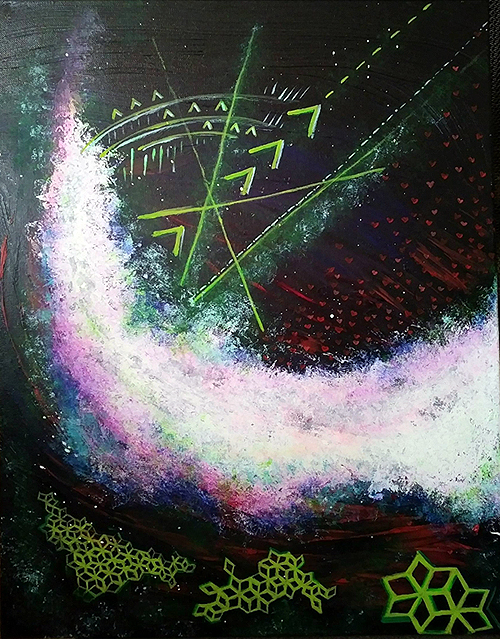
April Warchick -- "Navigating universal emotional life energy: love"
acrylic on canvas 36"h x 24"w, 2017.
When you have jet
lag it’s evidence that you traveled to a parallel universe and back...
You feel disoriented and exhausted when you come back.. Because you weren’t
compatible in this new time zone you have jet lag which means your getting
back to be compatible with your own personal world on Earth.... We all
have traveled to parallel universe already... Each time zone is a different
universe... Australia has its summer in December.. There are time zones
in which have their winter in December .... Time zones on earth are of
their own reality.... It’s the Longitude and Latitude who is responsible....
The slight change in gravitational laws to make unique time zone’s....
The universe is a giant web of mathematical gravitational slight adjustments...
Each adjustment customizes the of the law of physics and its that Longitude,
Latitude, Depth and Volume... The simplest calculus is the answer to figuring
out the engineering of these laws...
Each time zone has different genetic differences different languages and
religion’s.... So if you think of it then technically time zone’s
are a different parallel universe..... When mathematical equations radically
change and it changes the state of an atom that’s a different plane...The
parallel universe is close... Neighbor’s... Right next door....
Nicholas Robert
Grossmann
February 23, 2018
With NEH AND NEA on
the Chopping Block:
Is the Wisdom of the Sages the Answer to Indecisive Times?
April 28, 2017
In social circles, even if often just tongue-in-cheek, academia has long been derided as out-of-sync with “real world” practicalities. But, is this at all so today? Ever since the 1960s, when the National Endowment for the Humanities (hereinafter “NEH”) and the National Endowment for the Arts (hereinafter “NEA”) were established under the Lyndon B. Johnson Administration, academia was largely accepted and even normalized into American society. And, in turn, these Endowments have become almost universally accepted as requisites de rigueur of our advanced society. Perhaps that is why it is so disconcerting that their very existence could even be debated at the highest levels of our government. And so, where and to whom do we turn to guarantee their perpetuation?
Interestingly, Frederick W. Lawrence, Secretary and CEO of Phi Beta Kappa, the oldest and arguably the most prestigious honor society for the liberal arts and sciences in the United States, intimates that the answer may rest somewhere in or around “the ivory tower.” In Lawrence’s short but brilliant article “From the Secretary” published in the 2017 Spring Issue of “The Key Reporter,” Lawrence notes that the very legislation which created NEH in 1965, in which Phi Beta Kappa played an integral part, states “Democracy demands wisdom and vision in its citizens.”
Indeed, such “wisdom and vision” cannot be attained through a linear study of science and technology. Although we might be seduced by a techie society to seek the eradication of institutions such as NEH and NEA that have served us long and well, a fully functioning, free republic requires broad liberal arts thinking. One need only look to the razor-sharp minds that forged this union. Clearly, James Madison, Alexander Hamilton and John Jay were not “scientists” in a strict technical or technological sense. They were political and social scientists. Liberal thinkers and visionaries who were able to envision in The Federalist Papers a three branch government construct that would give rise to a more than two hundred year old union.
Actually, it may be these same type of visionary liberal arts thinkers, these modern day Madisonian types, who reside in “the ivory tower” to whom we must now look who can make the best case for the sustainability of these important Endowments. Frederick Lawrence seems to suggest that Phi Beta Kappa is equipped and poised to act in this regard.
In short, he notes in his article that the motto of Phi Beta Kappa is “Philosophia Biou Kybernetes” which translates “love of learning is the guide of life.” But he is quick to note that “kybernetes” also translates as “helmsman” or “pilot” while observing that “today, we find ourselves in uncharted waters, choppy ones at that. We need the love of learning to be our helm as we find our way.” He asserts that as the very continuance of NEH is up for debate in the days ahead, Phi Beta Kappa will be up to the task fulfilling “its historic role as champion of the humanities.”
Remarkably, it may not only be NEH or NEA who look to “the ivory tower” for their sustenance. As federal budgetary cuts are anticipated to cut through great swaths of our society, Phi Beta Kappa and academic societies akin to Phi Beta Kappa will be needed not only as “advocate(s) for the liberal arts and sciences” but as advocates for a free and democratic society. As a nascent nation needed broad based, visionary thinkers to create our union, we may again need cadres of intellectuals to simply sustain it. As anticipated federal budgetary cuts threaten not only the cultural institutions of our society but the most vulnerable among us, a modern day intelligentsia must not only act as “helmsman” to preserve said institutions and Endowments but as “a bully pulpit” and a moral compass to protect its people.
Donna Marie Joyce
Copyright April 2017
“The term “Cosmotheism”
was coined by Lamoignon de Malesherbes in his edition of Pliny the Elder's
Natural History to designate the ancient, particularly the Stoic, worship
of the cosmos as Supreme Being. I [Jan Assmann, in his work The Mind of
Egypt,] adopt the term in a somewhat broader sense, one that encompasses
polytheistic religions that worships the cosmos as the collective manifestation
of various different deities. In the religious history of the New Kingdom
[Egypt], cosmotheism materialized in three different forms: traditional
polytheism, revolutionary monotheism (which acknowledged the sun and light
as one sole divinity but also remained within the framework of cosmic
worship), and finally, pantheism, which regarded the supreme god of the
pantheon as the embodiment of all other deities and of the oneness of
the universe.
“Polytheistic religions worship not one single god, but a universe
of gods. This divine world is not merely a chaotic jumble of various deities
but has a specific structure. In Egyptian religion, three structural parameters
imposed order on this collectivity. First, language, through the narrative
structure of the myths, place the gods in systems of kinship and related
their actions and destinies to each other. Second, the cosmos itself represented
a model for the collective agency of various different powers. Third,
the organization of the polity assigned the gods divine rule in temples
and cities and interpreted the human exercise of power as a form of divine
rule by proxy. In this dimension, political community took the form of
cultic community or congregation.”
~ Jan Assmann The Mind of Egypt: History and Meaning in the Time of
the Pharaohs, translated by Andrew Jenkins, Chapter 15 - “Cosmotheism
as a Form of Knowledge,” page 204. Metropolitan Books, Henry Holt
and Company, New York, 1996.
Sadly and happily, I am a slow reader. Sadly because this has held me back in certain ways, but happily because it has given me the gifts of deep vicarious experience in slow motion, such as in reading the depth of discoveries and wonders in Ralph White's memoir "The Jeweled Highway." Even at my own pace, this book is a fascinating "page turner." Ralph is the co-founder of the New York Open Center, the most significant holistic learning center in any U.S. city, and since 1983 its Executive Director. Through its overseas Esoteric Quest conferences and New York lecture series, I've been privileged to know him since 1995.
As he describes in his book, he was a participant in the Findhorn spiritual/ecological learning commune in northern Scotland in the 1970s, and the program director of the renown Omega Institute where it had started in Bennington, Vermont. In 1981, he helped build its permanent center from an abandoned Yiddish camp in Rhinebeck, New York.
But, most of all, Ralph White's warm, poignant, and compelling narrative of his life story qualifies him as a true Humanist. From his early childhood in Wales his family moved for work to the coal-dust covered English mill town of Huddersfield, a place of tedium and hopelessness, devoid of any of the color of life or culture. Through academic achievement, he was able to attend Sussex University in the south of England, where his future began to unfold.
Crossing the U.S. to study in Seattle in the late 1960s, he then hitched with friends to Mexico, Guatemala, Columbia, and Peru to bus along treacherous mountain roads and climb to Machu Picchu. With vivid memories and a flowing writing style, White describes the hardships of these dangerous and lonely travels, and long, isolated periods of working to save up the money to escape the places where he'd been marooned on his way back. Eventually back in the U.S., these pioneering and exhausting adventures, and his own intellectual exuberance, gave him the renewed strength and resources to take on the hard work of creating and building up these learning centers which are at the forefront of the Consciousness Movement, providing profound alternative paths and learning experiences to city dwellers of both corporate and modest means. Even then, White's own path led to further and on-going amazing adventures !
For me, Ralph White's memoir has been a quest both along one Humanist's "Jeweled Highway" of life, and a journey to the spiritual richness of the crystal palace of Enlightenment. Great Work, Ralph !
~ Johnes Ruta
New Haven, CT
Independent Curator & Art Theorist
http://AzothGallery.com/
azothgallery@comcast.net
Book Info:
Ralph White -- The Jeweled Highway : on the Quest for a Life of Meaning
Forward by Thomas Moore
Published by: DivineArts -- DivineArtsMedia.com, 2015
Studio City, California
Amazon.com
Books
Cyra Levinson, Associate Curator of Education, Yale Center for British Art
Romita Ray, Associate Professor of Art History, Syracuse University
Jonathan Holloway, Dean of Yale College, Professor of African-American Studies, Yale university
From: Johnes Ruta, Art Gallery Director of the New Haven Free Public Library, http://AzothGallery.com/
Dear Cyra,
On my third visit on Sunday, November 23rd, to the YBAC's exhibition "Figures
of Empire: Slavery and Portraiture in 18th century Atlantic Britain,"
I was again curious as to the label of the introductory item of the exhibition
"Elihu Yale; William Cavendish, Second Duke of Devonshire; Lord James
Cavendish; Mr. Tunstal, and an Enslaved Servant" as the painting
is identified as "Unknown artist." As the question of this painting's
authorship was not specifically addressed in any of the three interesting
online interviews on the Yale Center for British Art web page for this
exhibition, I would like to make a contribution of my associated research:
As an art curator and theoretical analyst, I would like to respectfully suggest that the artist of this painting might be John Smybert (Smibert) (1688-1751). I am led to this idea, by a study that I made three years ago on Smybert's painting "The Bermuda Group" which is in the permanent collection of the Yale Art Gallery, depicting the Empiricist philosopher Bishop George Berkeley and his entourage, on the eve of their voyage to Newport in 1729. The stated purpose of their mission was to establish a ministerial training college on the island of Bermuda, a mission ultimately unsuccessful. John Smybert was born in Edinburgh, and worked as a painter and plasterer before coming to London where he studied with Sir John Thornhill. His painting style is similar to Thornhill's but much more distinct in his depiction of faces. This Smybert painting, which I first saw in the 2011 Yale Art Gallery exhibition "Life, Liberty, and the Pursuit of Happiness," is now on display in the permanent collection in the 2nd floor rear room of the new Street Hall section of the Yale Gallery.
On first seeing this "Bermuda Group" painting, my interest was invoked as an example of a peculiar branch of the 18th century philosophical movement Empiricism as taught by George Berkeley, whose outlook, as stated in his 1709 "A New Theory of Vision," was seen by many of his contemporaries, even such as Dr. Samuel Johnson, as a concept tantamount to solipsism. However, in the light of modern medical technology, CT Scans, and MRIs, we may consider that Berkeley was onto something closer to a modern physiological understanding of brain function.
My research essay on aspects Berkeley's brand of of Empiricism, and his intended application towards colonial psychology, as suggested in Smybert's painting, is attached [included below on this blog, ed.].
The date of circa
1708 is attributed to the "Elihu Yale..." group painting, at
which time Smybert would have been 20 years old. according to Richard
H. Saunders' thesis on John Smibert, the artist came from Scotland to
London in 1709:
http://books.google.com/books?id=Wklq3JItYOgC&printsec=frontcover&dq=%22John+Smibert%22+paintings&hl=en&ei=uIXhToHCLKjf0QG76o
DTBQ&sa=X&oi=book_result&ct=result&resnum=1&ved=0CEUQ6AEwAA#v=onepage&q=%22John%20Smibert%22%20paintings&f=false
In the "Bermuda Group" piece as in the "Elihu Yale," the same palette of vivid colors is applied, the positions, settings, and strong focus of faces are highly similar, and the sanguine painting tones of complexions are in the same palette. Both paintings are of similar large scale. The constellation of figures follows the same conceptual pattern. Most notably, compared to other painters of the time, the treatment of background motifs are uniquely similar, in the YBAC painting, with dark, indistinct trees on the left. In the background center of the YBAC painting stands the base of a large column, whereas, in the Bermuda painting the background stand a widely-spaced columnade. On the right, are more lightened, medium-brown trees with detailed limbs and branches, with closely matched yellow-green foliage, and a circle of children with joined hands. Both paintings share a high degree of suggestion of aspects of individual personalities of each figure. --- There is certainly also the possibility that John Smybert saw the "Elihu Yale" painting, and thereby followed its style. Following the failure of Berkeley's Bermuda project, Smybert settled in Boston, where his portrait work became successful.

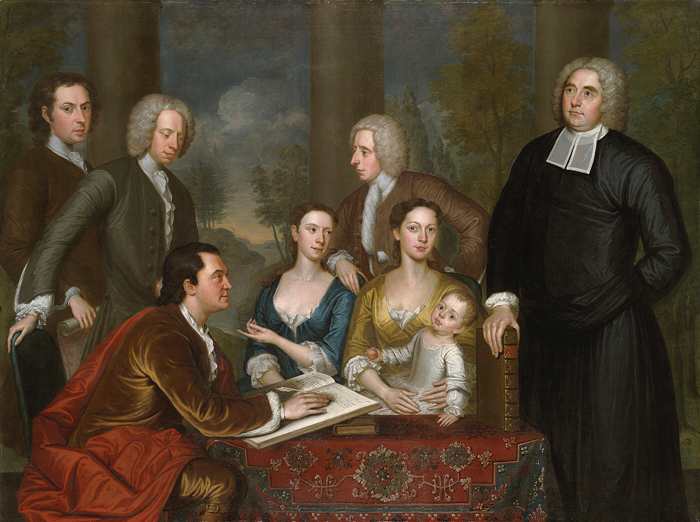
I would very much be interested in your opinions of these observations. Thank you!
Respectfully submitted for your interest,
Johnes Ruta
independent curator & art theorist -- since 1988; organizer of Philosophical
Forums
Art Gallery Director New Haven Free Public Library - since 2005
http://AzothGallery.com/
azothgallery@comcast.net
203.387.4933
22 Willard Street
New Haven, CT 06515
Smibert began drawing while apprenticed as a painter and plasterer, on moving to London he worked as a painter of coach carriages and a copyist.He studied under Sir James Thornhill at his academy, then travelled to Edinburgh and Europe seeking work as portraitist. He gained a reputation for his works copying old masters and receiving commissions for portraits in Italy and returned to England to capitalise on this.
Smibert painted a group portrait of the 'Virtuosi of London' society, of which he was a member; others in the group were John Wootton, Thomas Gibson, George Vertue, Bernard Lens, and other artists. He did not complete the painting, but did produce portraits in London up to September 1728, including one of Bishop Berkeley.
In 1728 he accompanied Berkeley to America, with the intention of becoming professor of fine arts in the college which Berkeley was planning to found in Bermuda. The college, however, was never established, and Smybert settled in Boston, where he married in 1730. He lived at the corner of Brattle Street and Queen-Street. He belonged to the Scots Charitable Society of Boston.
In 1728 he began painting "Dean George Berkeley and His Family," also called "The Bermuda group", now in the Yale University Art Gallery, Yale University, a group of eight figures; it is maintained that the person farthest to the left is actually the artist himself. He painted portraits of Jonathan Edwards and Judge Edmund Quincy (in the Boston Art Museum), Mrs Smybert, Peter Faneuil and Governor John Endecott (in the Massachusetts Historical Society), John Lovell (Memorial Hall, Harvard University), and probably one of Sir William Pepperrell; and examples of his works are owned by Harvard and Yale Universities, by Bowdoin College, by the Massachusetts Historical Society, and by the New England Historical and Genealogical Society.
In 1734, Smibert opened a shop where he sold paint, other artist's supplies, and prints. In his studio above the shop, he displayed casts and copies of Old Masters that he had painted in Europe. This collection, which Richard Saunders has termed "America's first art gallery", provided much of the early artistic education for Charles Willson Peale, Gilbert Stuart, and John Trumbull.
Horrors
Which Remain:
Examining Siegfried Sassoon and World War I
contributed by Jenni Farnsworth
It is an obvious and fundamental fact that artistic expression is both a form of personal freedom as well as being a challenge to (and weapon against) the kyriarchy and its numerous manifestations worldwide. Art is inherently subversive and uncontrollable; Audre Lorde wrote that the master’s tools will never dismantle the master’s house, and art is, of course, one of the tools with the power to both dismantle the old and construct something new. In the shadow of the 100th anniversary of the first world war, it is fascinating to examine the ways in which soldiers - themselves victims of the politicians who valued profiteering and antiquated colonial worldviews over human lives - used art to describe and grapple with the horrors they witnessed. Post-traumatic stress disorder was many wars away from being recognized, and so artists - particularly writers - strove to return a sense of individual lives to the massive, faceless numbers of the dead and dying.
“All a poet can do today is warn.” - Wilfred Owen
Today they are called the war poets (1), those young men who were brought to the trenches to die and who instead left proof that they had lived. Some - including Wilfred Owen - did fall beneath the weight of history’s careless cruelty, while others survived to write about their experiences with what would one day be called ‘post traumatic stress disorder’ (2). Although it is a step forward to recognize the very real trauma experienced by soldiers, to go beyond dismissing it as ‘shell shock’, there is also the danger of reducing it to a simple problem to be treated and dismissed. Hypervigilance, feeling of detachment, outbursts of anger, and harrowing flashbacks; these are the symptoms of PTSD (3), while also being a very human reaction to the wounding of the self which occurs when we observe, or commit, atrocities. Siegfried Sassoon, whose own life was a fascinating meeting of privilege and lack thereof, became an avowed pacifist in fierce opposition to the jingoistic, nationalistic sentiments which sent out the barely grown to slaughter other children in the name of peace (4). His poetry and prose rings out with the continual aftershocks of the war’s horror, as well as the empty promises of glory which were fed to young men with no idea of what they would witness:
You’re
quiet and peaceful, summering safe at home;
You’d never think there was a bloody war on!…
O yes, you would … why, you can hear the guns.
Hark! Thud, thud, thud,—quite soft … they never cease—
Those whispering guns—O Christ, I want to go out
And screech at them to stop—I’m going crazy;
I’m going stark, staring mad because of the guns.
from “Repression of War Experience” by Siegfried Sassoon
(5)
“I am making this statement as an act of wilful defiance of military
authority” - Siegfried Sassoon
Supported by pacifists such as Bertrand Russell, Sassoon’s “Finished with the War: A Soldier’s Declaration” was read out in the British House of Commons and published in the London Times (6), a brave and fierce act of speaking truth to power. For refusing to bow to the “war of aggression and conquest”, Sassoon risked his very life; having survived his time in the trenches, his life still laid in the hands of politicians, who may very well have sentenced him to military execution. The forerunner of PTSD (7), shell shock, was instead blamed for his outrage - as shell shock was a politically motivated diagnosis (8), this subversion of its intended use stands as an attack of its own against the powers that be. Sassoon was forced into treatment for his ‘war neurosis’, where he met Wilfred Owen, also suffering under the weight of his experiences. Both returned to the frontlines out of a sense of duty to their fellow soldiers, who suffered under the yoke of regimes both understood to be self-serving liars. Sassoon returned from the war; Owen did not, and died at the age of 25 (9).
If you could
hear, at every jolt, the blood
Come gargling from the froth-corrupted lungs,
Obscene as cancer, bitter as the cud
Of vile, incurable sores on innocent tongues,—
My friend, you would not tell with such high zest
To children ardent for some desperate glory,
The old Lie: Dulce et decorum est
Pro patria mori.
from “Dulce Et Decorum Est” by Wilfred Owen
Notes:
1. “Modern
History Sourcebook: World War I Poetry”, Fordham University,
last accessed May 28 2014
2. “The Penguin Book of First World War Poetry”, Penguin, last accessed May 28 2014
3. “PTSD (Post Traumatic Stress Disorder)”, PsychGuides.com, last accessed May 28 2014
4. “Siegfried Sassoon”, The First World War Digital Poetry Archives, last accessed May 28 2014
5. “Fateful Memories: Industrialized War and Traumatic Neuroses”, Journal of Contemporary History, last accessed May 28 2014
6. “Form and Uses of Language”, the Open University, last accessed May 28 2014
7. “PTSD History and Overview”, National Center for PTSD, last accessed May 28 2014
8. “Broken Men: Shell Shock, Treatment and Recovery in Britain 1914–1930”, Oxford Journals, last accessed May 29 2014
9.
“Wilfred Owen”, Shropshire Tourism, last accessed May 29
2014
This Pretty Poetics
by Maxwell Clark
"Have you practis'd
so long to learn to read?
Have you felt so proud to get at the meaning of poems?
Stop this day and night with me and you shall possess the origin of all poems[...]"
--Walt Whitman, 'Song of Myself'
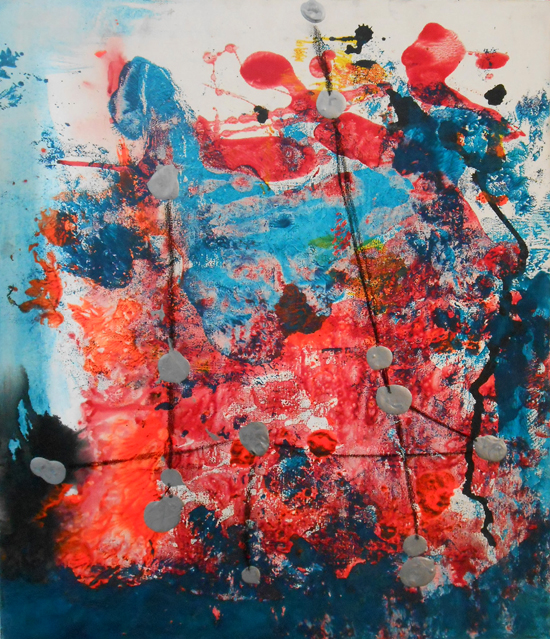
Poesy is the doing
of anything. Poesy is there in the poet who works out any poem. A poem
is any product of any behaviors whatsoever. Each of us who do things are
poets. Each of us poets are the unacknowledged legislators of our common
world. Each of us is also dependent on the poesy of the other poets going
beyond us, as if we ever were alone, for each of us to be most fully beautiful.
Beauty is the excess of light over from within gravity, or an excess of
what is over and apart itself, i.e. desire. Poesy affirms desires, in
whose faith is their creation.
The prettiness of any poesy or poet or poem is the beauty of their gravity-overcoming
light within gravity. Desire is desire for more light to be released from
gravity. Or perhaps not released, but melded further into the empty abyssal
compaction of gravity, if just so also as to become the more unmixedly
luminous. Poesy is the beauty of light emanating from, in, around, and
of gravity. Any poem is just an aspect of light jutting out into some
precarious stasis with the otherwise abyssal compaction of gravity.
Poesy teaches
the life of the poet in their poem. Poesy expresses what remains of the
poet there in their poem. The poet thus addresses others. But only insofar
as others before affected the poet with their immemorially more raw desire.
A poet only focuses the prior desires of their others, i.e. brings their
light over above and out from gravity.
.....
Others
either hide away or show forth their own faces of light across from the
gravity of the poet’s subjectivity. A poet subject to the gravity
of themselves alone is no poet. Only their inspiration by the light of
the presence of their others secures poets as poets.
.....
Others either face
the poet in the beautifying light of their poesy or they turn away. The
more others turn their light from the poet the less each and every one
of these poets is beautiful. The poesy of a poet is the facing of others
towards, into, through, and then beyond the herein absolutely passive
presence of the poet. Poesy is the facing of the other’s light through
a thus beautified receptacle of a poet and their attendantly generated
poems. Others face a poet’s poem as themselves gone beyond themselves
through this poet, as an aspect of the ensemble of others (also poets)
facing their light through this poet.
......
Light is the poesy which gravity compacts into poems. The poet is an enclosure of gravity suffused with too much light. A poet is already a poem. A poem is already a poet. Poets and poems are local accretions of the cosmic metabolism of light and gravity. .......
A poet is a gravitational
density more or less porous with light. The poem, as the poet, materializes
in how light ever disarrays gravity’s inertia. As was the poet,
so is their poem. Poesy is the interminable proliferation of light within
gravity.
........
The poet is the poem
is the light of poesy overcoming gravity from within. There is not any
way to predict any future forms taken by the catalyzation of gravity by
light. Nor is there any method for securing the least regularity in poetic
outcome on this cosmic register of poetic formation. Future poets and
their poems will take hold as formed only out of the chaotic generativity
of gravity and light, any otherwise more telling details are futile to
assume.
.........
A poet, as their poem,
is a face that conveys more or less of the light of many otherwise faces.
Poesy is not in the gravitational attraction of a poet or poem on others,
it is in how the light of others’ faces somehow shows through the
self-enclosing gravity of a poet or a poem.
..........
Poesy is light weighed
down by gravity. Poets and poems are local mixtures of gravity with light.
Poesy is never the doing of one poet alone; poesy is the facing of an
otherwise light in, through, and beyond the poet, until gravity reclaims
this inspiration as a discretely compacted poem.
...........
Gravity slows the
poesy of light into poets and poems. Poets and poems are torpors of light.
Light has no poesy, produces neither poets nor poems, minus its reciprocal
presence within its antitype of gravity.
............
~ by Maxwell
Clark January 4. 2014
maxclark84@gmail.com
These habitually grace-like suspensions of my own consciousness I experience while painting do not signal the absence of cognitive work from my compositional process. My paintings are nowise unthinking, only preconscious[1] in their logical element or guidance.
It is almost miraculous: when painting, I find myself very significantly relieved of all but the least flickerings of consciousness in my waking life, thus also all of its intentionalities, symbolisms, imaginations, fantasies, delusions, etc.
However I feel, or am, I most directly and immediately express. I have somehow habituated myself to express my affective conditions on canvas prior to or minus any aesthetic ideologies.
Other, more cortex-mediated paths of abstract thinking and aesthetic method lack the candor and vitality of my ability to follow my more direct, decentralized, and unspecialized nervous excitations.
Defining sets of aesthetic laws for painting, or incorporating consciousness into aesthetic composition, is very often a futile exercise, verging sometimes even on a serious impediment to the fullest creative growth of painters.
This guidance of my nerves, or my obedience to my most immediate perceptions of sense, these are my general observations of myself as a painter alone, they are not present in my mind while I compose my works.
And my promotion of my nervous instincts over my more normative cognitive systems, this abnormality of my artistry is also an emblem of my wider societal abnormality.
I never intend to do anything when I paint, but perhaps it will, just as such, allow me to escape the brutal mediocrity of normative societies, as also avoid any further psychiatric hospitalizations.
Painting is a world wherein I am more allowed to be abnormal, in my special sense of sensuous hypnosis as perhaps in others.
~ by Maxwell Clark Sept. 2013
maxclark84@gmail.com
--------------------------------------------------------------------------------
[1] The preconscious, as in Freud, is the “non-repressed”
unconsciousness, whose activities are far more easily brought into consciousness
than many other of the more repressed elements of the unconscious. My
paintings, as such, are not very truly explained by the fields of depth
psychology, dream interpretation, or any neurotic repressions, etc. If
I simply do not think the fully repressed contents of my psyche have or
will or even can come to surface on my canvases, this is insofar I am
enough aware of the tremendously difficult science (linguistics) of their
psychoanalytic cure.
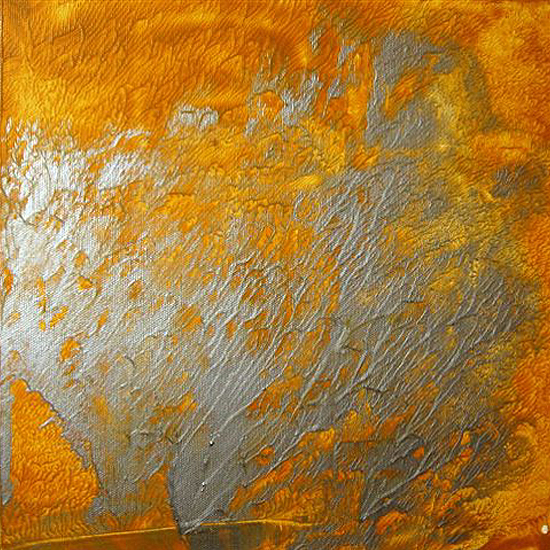
Sulphur is a chemical which is also called Amlasar Gandakh, is yellowish in colour and is solid at room temperature. In scientific language it cannot be liquid at room temperature but after doing a lot of work on it I have prepared liquid pure sulphur or oil of sulphur which is dark yellow and orange yellow in colour, but it is not sulphuric acid it is only permanent liquid sulphur at room temperature. It is liquid pure sulphur without reacting it with any chemical. I have read in old granthas it is used to cure leprosy and other disease.
I have prepared pure liquid Sulphur or oil of Sulphur, liquid ammonium chloride, white copper, white ash of cinnabar and red oil of cinnabar which is used to cure diseases, but I don’t know where to test it so I want to know that if all these things are effective in curing some incurable diseases where to send it for testing. If anybody interested in this or want to do research in any scientific laboratory or want to test it for use can contact me.
Gobind Kapoor. (kimiya2576@yahoo.in or hargobindkapoor25@gmail.com)
09914845109
INDIA.
Philosophical art review by Johnes Ruta:
"The Bermuda Group (Dean George Berkeley and His Entourage)"
an 18th century painting by John Smibert

Oils on canvas, (begun 1728, completed 1739) 176.5 x 236.2 cm (69 1/2 x 93 in )
by John Smibert, American, born Scotland, 1688 - 1751
Painting on display in the Yale Art Gallery exhibition
"Life, Liberty, and the Pursuit of Happiness"
thru December 31, 2011, and now in the Permanent Collection.
essay by Johnes Ruta, AzothGallery.com
Solipsism is the philosophical idea that only one's own
mind is sure to exist, the epistemo-logical position that knowledge of
anything outside one's own mind is unsure. To better understand Berkeley’s
Immaterialism, we should compare it to the principles of solipsism, which
are divided into defined into three levels: 1. Egotism, that is, the isolation
or self-perceived supremacy of the individual personality; 2. Metaphysical,
encompassing the questions of philosophy regarding individual perspective
and relationships; and 3. Epistemological, in the study historical
development of the field of knowledge, in this case of the juxtaposition
of matter and perception.
The principle of materialism can be traced back in the West to the beginnings
of thought about nature and the composition of the world: Around 585 BCE,
the astronomer Thales argued that matter is derived from water and is
always in a state of flux. Around 80 years later, Heraclitus compared
the sensation of the passage of time to the flow of a river. Heraclitus
also postulated that Fire was the basic matter of the universe, also that
all things are in a state of flux from am opposite perspective, thus in
a process of “Becoming”. Parmenides, born
510 BCE, opens the door from physics into “metaphysics”
– whether “being” is objective or cosmic: In the sentence
structure of his allegorical story-telling in On Nature, and later in
The Way of Truth, and The Way of Seeing, he constructs and uses new linguistic
conjunctions of subject, verb, and predicate objects to both establish
and equivocate objects which exist thus illustrating them as the
focal points of experiential reality. This technique thereby raises the
dialectical question of an existential nature of “Being,”
that is, human experience considered in a cosmological context.
In modern Western philosophy, the epistemological doctrine had been begun
as a core tenet of Descartes—that what is in the mind is known more
reliably than what is known through the senses. Descartes, trying
to establish the continuity of personal identity, and as a remedy to an
inevitable skepticism of everything, proposed that the continuity of the
“self” derives from thought. This would soon enable the extreme
view that the orientation of the senses is the sole reality of the world.
John Locke in his Understanding of Human Experience came to the conclusion
that we are not born with any innate knowledge, even such as the presence
of God, and that human identity is “the gift of experience”—
that the sum of these is what defines the personality. The
first prominent modern Western idealist in the metaphysical sense was
George Berkeley who argued that there is no deep distinction between
mental states, such as feeling pain, and the ideas about so-called "external"
things, that appear to us through the senses. There is no real distinction,
in this view, between certain sensations of heat and light that we experience,
which lead us to believe in the external existence of a fire, and the
fire itself. Those sensations are all there is to fire. Berkeley expressed
this with the Latin formula esse est percipi: "to be is to be perceived."
In response to Locke, Berkeley put forth in his Treatise Concerning the
Principles of Human Knowledge (1710) an important challenge to empiricism
in which things only exist either as a result of their being perceived,
or by virtue of the fact that they are an entity doing the perceiving.
(For Berkeley, God fills in for humans by doing the perceiving whenever
humans are not around to do it). In his text Alciphron, Berkeley maintained
that any order humans may see in nature is the language or handwriting
of God.To trace the theoretical history of Berkeley’s logic, this
form of perspective is carried to its logical extreme in his view of the
world which defines a subjective reality for each person, in which there
is no other material dimension than the pure imports of each person’s
own perceptions. It is as though when one walks from one room to another,
the physical reality is only that in which one is present from moment
to moment, and forms as one arrives, and is dissipated and disintegrated
from the space from where one has moved away. Berkeley's “Immaterialism”
is defined as a subjective idealism in which is a purely subjective uni-verse. The
disconnect favored is between the senses and any acknowledgement of an
independent material reality, and that there can be no distinction
between primary and secondary qualities of objects, because objects themselves
cannot exist unless perceived by the senses. Berkeley would go on to
reject both Newton's system of Fluxions, which Leibniz also developed
as The Calculus, and Leibniz' mathematical theory of Infinitesimals,
as based on introspective measurement of particulate existence,
which would acknowledge motion in an external material reality.
Berkeley's philosophy was mocked and rejected in his own time by many,
even by the lexicographer Dr. Samuel Johnson, who while walking in the
woods, demonstrated his view of Berkeley's error by the act of kicking
a stone, "I refute Berkeley thus !"
The interpretations of Berkeley's philosophy range from it being
seen as a denial of any external reality, to a more comprehensive
view that now appears an as advanced theory of the functions
of brain synapses in cognitive science -- that all perceptions form cohesive
patterns in the mind reflecting real external realities.
In this nearly mural size painting nearly 8 feet wide by 6 feet in height,
John Smibert has captured a revealing situation: the essence of solipsism
that Berkeley’s ideology encapsules is evident in the expression
of each figure: George Berkeley himself gazes off into the heavens,
looking diagonally upward across the foreground of the painting.
His mind is set on the functionality of the Church of England as a tool
to promote the greater solipsism of the Crown of England: his college
has been designed with the purpose to train Presbyterian ministers who
will be disseminated to the colonies where they will work to keep the
indentured servants, slaves, and Native American “savages”
from rebelling against the ceaseless exploitation of their plantation
masters, under the threat of eternal punishment. Berkeley’s
right hand rests upon the authority of the Book, perhaps either a law
book, or one of his own published philosophical treatises. His left hand
is folded in a properly posed, yet unconsciously sinister hidden manner
around his back. Berkeley’s friend and sponsor John Wainwright sits
at the left looking with adoration at Berkeley, his hands inscribing George’s
pronouncements. Berkeley’s wife Ann and infant son Henry gaze
out at the viewer, as does the figure at the far left attributed to be
Smibert himself, all seeming to appeal to the empathy of the viewer. Ann’s
companion Miss Handcock looks to Ann at her left, while she quietly points
with her left hand to the wigged person of John James standing at her
right, as though he were her paramour. Meanwhile Richard Dalton stands
behind her left side with his hand poised on the back of her chair, in
the proximity to her bare shoulder, while gazing with an expectant, almost
inviting look at John James, whose own eyes fixedly press down ambiguously,
or flickeringly, both in the same direction as the writing in Wainwright’s
large book, and upon the glowing skin of Miss Handcock's open, elegant
décolletage.
So here we have a topographical map manifesting the essence of Berkeley’s
theory of “Immaterialism,” which had been published in 1709.
Each figure exists within the epitome of their own subjective reality.
…
This is a weird painting, in which Smibert, we know not whether wittingly
or unwittingly, has nailed the impertinent political reality of Berkeley’s
“Immaterialism,” in which each character on the surface appears
to be part of a cooperative group mission, but in deeper, more subtle
personal reality manifests their own self-seeking interests. . In political
terms, I would describe Berkeley’s principle as “Reality Chauvinism,”
and it can only be related in practice as the anticipation, 150 years
ahead of its time, in the expression of “Social Darwinism”
of the late 1800s. Smibert was hired to teach art at the College, and
accompanied Berkeley, his family and entourage, but without Wainwright.
They sailed instead to the American colonies, where they finally landed
at Newport. There Berkeley bought a small plantation, while awaiting
the government funds to arrive that had been allocated to start his Bermuda
College.
Were we to compare the land forms of Bermuda itself to the background
landscape of the painting, we would detect an exaggeration of the rocky
coast, and inaccuracy of the type of trees depicted. Smibert soon
left Newport and went on to Boston where he lived and worked the rest
of his life. As a portraitist in the colonies, his artistic vision became
the prominent trend-setter for American portraitists of the rest on the
18th century. Berkeley went back to England in 1732. Some of
Smibert's other multiple portraits such as "Sir Francis Grant
and His Family" 1718, "The Continence of Scipio"
1726; "Daniel, Peter, and Andrew Oliver" 1732;
as shown on Richard H. Saunders on-line book on Smibert here.
do give some interesting clues to the interpersonal
dynamics found in “The Bermuda Group” more difficult to analyze.
However, Berkeley’s stated purpose to create the Bermuda College,
in order to supply the churches of the New World with ministers, no doubt
trained in Berkeley’s perspective, would be agents first to perpetuate
and ensure the rule of the King of England, that is, the imperial singularity
of the monarch in the order of the “divine right of kings.”
More to the point, Berkeley’s mindset was built to preserve the
social order as the perceived and correct order of the universe : God
maintains the imperial "observership" of all actions in the
world, and hands down the protectorship of the moral order to the king,
then the nobles, then the wealthy plantation owners. In this century
in the New world, as in the Old, rights are the dominion of "Real
Politic", specifically the class of land-ownership. The social
order must be maintained against potential and feared uprisings of those
“savage [native] Americans,” and the indentured servant and
the slave classes who worked those plantations of the southern American
colonies…! This was not the Humanism of John Locke,
who advocated the principle of "the greatest good for the greatest
number." For those workers no “subjective reality” would
be permitted in any society or in any plantation church community
before the American Revolution, and for the slaves, not until the Emancipation
Proclamation. Subjective Idealism was surely only a domain of the
privileged classes, and is still being fought for in the 21st century
– witness the Arab spring and Occupy Wall Street movements.
Ironically, in terms of any persistence of Berkeley’s reality, when
he left England and came to Newport, it appears that his arrangements
of reality for the disposition of funds to found his college on Bermuda,
then faded in the real world of English politics. Reality check.
Claudine Burns-Smith wrote:
It's amazing how different interpretations of the same painting can be given, and they are not mutually exclusive. Seeing this painting sent you on a historical philosophical interpretation but here is another one, more psychological:
Dean B. and his family form one group. He is lost in his lofty philosophical and religious ideals and does not know what is going on around him. She is down to earth, busy with real life taking care of a child, and not afraid of honestly looking us in the eye. She looks very centered and confident in who she is. Let the others worry about the spiritual world.
Sitting on the left is Wainwright, the fan, taking down every word the great man utters. But he is just a symbolic presence required as an audience for Berkeley.
The two wigged gentlemen and the other woman are interesting characters. The one on the right has his arm possessively resting on the back of the woman's chair, suggesting he might be the husband. The woman is looking at B.'s wife, probably confiding in her, but is pointing at the other guy. What is so special about him? He is looking down at what you might think is the notebook held by Wainwright but could it be he is actually examining the woman's bosom that she is displaying in his direction so prominently. Is he her lover? Do we have a triangle here?
The last character, actually a self-portrait of the artist, is looking angrily straight at us, seeming to tell us we have no business seeing this scene. We are voyeurs witnessing the secret drama of two dysfunctional families.
Of course there is also the artist's interpretation analyzing colors and composition.
Anybody can make up stories about paintings and I had fun doing this
one. I am glad you liked it.
Happy New Year!
Claudine
Magdalena Mraz wrote:
Hi Johnes,
All the best in the coming year! It certainly started with the great promise of your interesting essay on painting by John Smibert. I believe that your observations of the personalities in his painting and their "enlightened self-interest" is keen and correct (how many times have I heard this fundamentally contradictory phrase defended in my upper east side Unitarian church?) It reminds me of frequently quoted Thomas Jefferson and his peculiar mixture of idealism and pragmatism; perhaps a term "Immaterialism" would fit his philosophy as well as Berkeley's.
To me, the most interesting
portraits in this painting are those facing the viewer directly. Intelligent
and maternal gaze (with a hint of irony) of Dean's wife seems to belong
to a female who represents a good grounding force for her rotund yet "immaterial"
husband. The child she is holding suggests a possibility of a fresh start
and perhaps an amusement of a future generation viewing the pompous setting.The
most captivating, however, is the very direct, piercing glance of an artist
himself, reminiscent of an insertion of Diego Velazquez into his painting
of the Spanish royal family ('"The Maids of Honor", I think).
He appears to see himself at once as a witness, social critic and a detached,
somewhat elevated observer. Although in the background and almost added
to the picture, he is the one holding the true power, not prominently
placed Berkeley. So I believe Smibert managed to mock all the other males
in the painting, sharing the ground with the mother and the child instead.
Thus he gave himself the best spot and got paid for it too. How is that
for an enlightened self-interest, if not entirely "immaterial"
philosophically in this case. But at least he is the most unpretentious
person in the group. Never under-estimate the power an artist! I am happy
(and envious) you are beginning to practice the power of your art of writing
again, but it helps to increase my own writing urges too.
Warmly,Magda
Nick Grossmann wrote:
a thought
Hey bratha!! Hey dude...I've been obsessing about god or higher power..Anyway people never understand that it always existed..so today i pondered and came up with an argument that it always existed and it involves the number zero..i don't know if someone lese has made this up but tell me how you feel about this...
First there was nothing and the mathematical equation for nothing is zero...Zero is just a ghost...Zero is the seed...Now the seed grows into a flower...The seed which is the ghost or just a spirit had a thought and it manifested it into the physical...So then the creation process began as the flower pollinated and created more seeds which spawned into more and more flowers..0 + 1 = 1 spirit + th...ought = creation...So zero could be the most powerful number...Weather you believe in a higher power or not it makes you think that if nothing is the number zero then that could argue if there is a higher power that it always existed ... That zero...the ghost... A spirit manifested its thought to create into a physical manifestation and that spirit was a seed and created the flower of life so you can say zero is the highest and most powerful number...
Johnes Ruta wrote:
Hey, Nick, thank you for your brilliant understanding of the question of Being vs. Nothing! -- Your concept and theory of the ZERO are crucial in this understanding. There are many facets in our relationship to "Reality" as the activity of our presence in Time and Space. ZERO IS the both place-holder of the quantitative universe, AND the bubble of the Void of the cosmos, AND the SEED of the flower of Consciousness. Einstein used the term "World-Line" to describe the ascending path of consciousness over a period or a sequence of moments, translated as points of measured Time over days, years, or centuries. These moments are each a bit of experiential essence. They are also the path of Evolution -- the unfolding of the Flower... To reconcile the principle of Becoming and the principle of Being, I would say that we must allow ourselves the perception of the intense moment-by-moment awareness of the technicolor cosmic energies that surround us -- that Consciousness is "Being," and Being is Consciousness. "Time" is the motion of Fluid energy. Growth and Evolution are the "Becoming."
Valeriu Boborelu wrote:
ABOUT JOHNES RUTA’S ESSAY
“THE BERMUDA GROUP” AND BERKELEY’S
PHILOSOPHICAL CONCEPT OF IMMATERIALISM
by VALERIU BOBORELU
CHAIR OF PAINTING (1978-1985)
Nicholae Grigorescu Academy of Art,
Bucharest, Romania
Johnes Ruta, a complex writer and art critic and reader of Western Philosophy,
presents an interesting and challenging essay which reflects social-spiritual
tendencies in human society from Berkeley’s century until our times.
The idea of writing this essay was inspired by John Smibert’s 1729 painting of “The Bermuda Group,” displayed in the Yale Art Gallery exhibition “Life, Liberty, and the Pursuit of Happiness.”
The artist Smibert depicts in a traditional and documentary style a major figure of Eighteenth century philosophy, the David George Berkeley and his entourage – family, sponsor, and teaching administrators. Ruta gives a subtle, aesthetic description of the painting, compositional disposition of personages – dominated by the tall stature of Berkeley. The figures are related to the whole atmosphere of art work, but in the same time each of them seems to have their own mind-inside preoccupation – similar to Berkeley’s concept of Immaterialism that Ruta relates to solipsism.
Berkeley and his group descended from London in 1729 with the main goal to create on the island of Bermuda a college “for better supplying of churches in our foreign plantations” and to convert the people to Christianity.
Inspired by the philosophical ideas of Berkeley, Ruta develops a multi-layered social-spiritual web which represents a dynamic, dramatic relation between Idealism and Materialism, the continuing search of the human mind to define the truth, the reality, and the field of knowledge. He considers Berkeley a preeminent figure in the philosophical movement called Empiricism. This system originated with thinkers like Epicurus (senses: valid source of knowledge), Thales, Aristotle, Descartes (mind perception is superior to the senses), John Locke (experience if essential), or Leibniz.
Ruta shows that “in terms of categories of Idealism and Materialism, the concept of Immaterialism – argued by Berkeley has been variously misunderstood.” and also, when the idea of Immaterialism “became close to solipsism (only one’s own mind is sure to exist), there have been generated conflicting interpretations…” The principles of solipsism can be summarized as: 1. Egotism (isolation of the self), 2. Metaphysical (individual perspective), and 3. Epistemological (history of the field of knowledge.)
Ruta emphasizes that Berkeley, as this “preeminent Western Idealist in the metaphysical sense” sustains that deep distinction between mental states and external things, and, Ruta continues, “Berkeley expressed this with the Latin formula “Esse est percepi” (To be is to be perceived.) , and thereby concludes that “Berkeley’s concept of Immaterialism is carried to its logical extreme “with this view of the world which defines a subjective reality from each person” (a purely subjective uni-verse.)
The philosophical Berkeley sees the whole universe as a manifestation of a supreme deity, the God and “any order humans may see in nature is the landscape of the handwriting of God…”
In the Eighteenth century, the sophisticated term of “Immaterialism” (and solipsism) would be applied only to the privileged classes, superior beings, and the land-owners (“to preserve the social order as the perceived and correct order of the universe.”
In the conclusion of his essay, Ruta says “Subjective Idealism,” as proposed by Berkeley, was surely only a domain of the privileged classes and is still being fought for in the 21st century. There are indeed many problems of our contemporary world: social movements discontent with governments, the struggle of people to find truth, the correct relations between the members of society. Inspired by Ruta’s essay, I would like to present some additional ideas, concepts from some philosophical thinking, religious teachings, and some spiritual thinkers and writers.
* Buddhist School – Vaibhasika
-- Direct Perception and inference are valid conditions.
-- Existence of: * sense perception
* mental direct perception
* yogic direct perception
-- existence of Ultimate and Relative Truths.
* Buddhist School – Sautrantikas
-- existence of Ultimate and Relative Truths.
-- Ultimate Truth: a phenomenon that is able to perform a function.
-- things that exist momentarily.
-- physical sense powers are not valid cognition.
-- mental perception is valid cognition.
-- existence of direct perception: sense, mental, yogic, self-consciousness.
* Buddhist school of Mind only (Cittamatras)
-- the basis of all phenomena is the mind.
-- the appearance of all external objects is similar to dreams; external objects do not exist and they only exist in the mind.
* Buddhist Mahayana school
-- all phenomena are in a continuum of change, and flux movement.
-- all phenomena are depending arising: depend on causes and on conditions.
-- Theory of Emptiness: lack of inherent existence.
-- Selflessness * of beings
* of objects
-- all phenomena are impermanent , except 3 categories: * emptiness
* space
* analytical and non-analytical
-- the existence of the mind of clear light : the most subtle mind, the Buddha nature
-- Bodhicitta : the love, compassion for all beings
-- the Great Beings – Bodhissatvas – take the vows of Bodhicitta – to help all other beings to become liberated from Samsara abd obtain supreme state of Enlightenment.
-- Buddha Sakyamuhti : never think “I, mine, me.”
* Sri Ramana Maharishi -- the essential question: Who am I ?
-- the nature of self : contrary to perceptible experience, not an experience of individuality
but a non-personal, all-inclusive awareness.
* Self = God
-- the self is ever present
-- the silent self is god
* Sri Chinmoy
-- “Man and God are eternally one.”
* Pard Mahansa Yogananda “The Divine Romance”
-- “Christ is right here, he can be seen if you look within your
forehead at the point between the eyebrows, the center of Christ-consciousness,
the seat of the single or spiritual eye.”
* Caroline Cory “The visible and invisible worlds of God.”
-- the Creator Source is without beginning and end.
-- the Creator Source is not one being or one person. It is layered multi-dimensional existence.
-- we are one minute particle of the Creator Source.
Creator Source
|
|
+
Creator Consciousness
| |
| |
Divine Creator Creator Energy
(Father) (Mother)
| |
|_____________|
|
O Massive Body of Light-consciousness
particles “Split-off”
|
__________________________ |_______________________
| | |
Divine and Celestial Solar and Planetary Intelligent
Beings Systems Evolutionary Being
* Gabriel of Sedona “The Cosmic Family”
-- our planet is going through important changes : we are passing now
from 3rd to 4th dimension.
-- subtle, superior beings are involved in helping our planet.
-- some of these great beings take the human re-personalization in order
to help direct our planet.
-- Deo-Atomic = atomic structures in alignment with God and Paradise absolute
and are connected to cosmic vibration patterns.
-- Deo-Atomic Cells aligned with Paradise absolute and are cells of future
Light Body.
-- the fourth epochal revelation was fulfilled when the Creator Son of
our local universe,
Christ-Michael bestowed himself as a human mortal, Jesus of Nazareth to portray the nature of his Paradise Father.
* Urantia – the cosmic name of our planet.
-- Urantia is Planet 606 in the system of Satania, in the constellation of Norlatiadek, in the universe Nebadon, in the super-universe of Orvonton.
-- Michael (Christ) of Nebadon chose among all the planets in his universe for his Seventh Bestowal, as a human mortal, in which he revealed the loving nature of the Universal Father.
-- Urantia is sometimes called “The World of the Cross” because it is the only planet in the 700,000 local universes where a creator son was put to death by his own creatures.
* KRISHNANANDA (“2012 End or beginning.”)
-- “There are ‘Light Beings,’ Astral Masters and a Divine Plan waiting to help us and gift to us higher living facilities and comforts. We have to get ready to receive them. We can qualify by just going back to our original state : the state of love, peace, and truth. Positivise, remove all violence, corruption and aggression.
-- We have to meditate and channel Light a lot to transform. It is actually possible for the transition into the Light Age to be peaceful; and painless.
* Quantum Theory
-- All our thoughts, emotions, and activities are recorded on a subtle level (“Crystal Cave”).
When we are passing away the recordings from the “Crystal Cave” are transferring to the matrix of the Earth (the subtle energetic grid) for the benefit of Humanity.
January 2012, Valeriu Boborelu
Paul Szemanczky wrote:
Brilliant! I believe it's all energy related through fractal sciences and arts. That same energy is conjoined with us to all the dead, dispersed through the Cosmos. The solar energies make up 98% of all the energies and are engaged in 'conversationing' far beyond our understanding, but it is what we will 'become' upon our deaths. The true motherboard of our conversing energies lies with dark energy and dark matter; which I hold is fugue energies.

Theory by artist Nick Grossmann
Let us just look at 8 now and imagine a cosmic hour glass and let us think that the sandwich can resemble the Present and Existence is being sucked through the 8 or the cosmic hour glass, and it is then alternated to go over and over sucking sand... Now wonder...Can there be a dimension and is it an eight that keeps time...and if this was so, then as the sand gets recycled then would time be recycled and turned over going into the other side of the hour glass or 8 or cosmic hour glass....
Now what if the universe was the shape of 8 and the 8 is made of a 3 and a backwards three which combined as 8 makes two cosmic loops.... Now this may sound radical, but what if in the middle of the 8 was a zero and that zero can be a black hole sucking the universe and matter through the black hole and to the bottom half of the 8 just like sand going through the hour glass.... .With this theory of course it doesn't prove anything but it makes you think that if this is true then there is no past or future and just moment or the present.

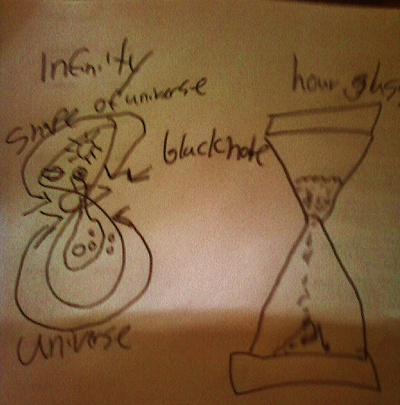
From Paganism to Mysticism to Religoin the number three has always had some spiritual purpose....The top point of the three represents the upper world, the botom point of the three represents the lower world and the middle point represents the present physical world... Could it be fair to say that the number three is some key to harmony or enlightenment?? Like if there maybe a balance of upper and lower world would that bring harmony.....The middle is a cosmic loop and we can say the middle point of the three is a zero....The zero is a spiritual number in mysticism for a portal witch maybe it is fair to say is the present and the moment....Maybe the key to all this and the number three is learning to live in the present...I once jamed out in a band and the lead singer used to say God was in the present....With the number three the top and bottom meet in the middle and the middle can be what represents the present and maybe the key to life is being in the present...
This is why we have and what the world is -- third dimension....from the upper and lower world combined in a cosmic loop.....I wonder what other keys there are with other numbers to unlock dimensions???
The full moon. When the earth,moon,and sun are combines...Could this have to do with the mystical number three? They say its the best time to do spell work and its not 28 days its really 29 days...so looking at 3 originally the top (higher) the middle (physical) and the bottom ( lower) while you look at three like that look at the time of the full moon and look at 3 which in theory the top which is our sun can represent higher the middle this time is the moon and that can represent lower and the bottom instead of lower world is earth our physical which makes the full moon effect and gravitational changes ideal for spell work and anything metaphysical.. My point is looking at "3" the combination of the three worlds upper,physical,and lower can be switched around to go into another cosmic vibration such as the full moon and also women tend to give birth on that day which is 29 days not 28...technically 29...so with 3 would it be fair to say that you can metaphysically play with the combinations???
And if these cosmic
bodies align then think of other combinations of moons,sun and planets....could
it be the keys to unlocking difrent dimensions or realities if done correctly??
An Art History of the Early Renaissance by JOHNES RUTA (New Haven, CT)
A Literary Theory: PROLEPSIS: The Dream of Consciousness
by JOHNES RUTA (New Haven, CT)
A Critique of [Im] Pure Criticism:
An Outline of legitimate Criteria for Art Criticism
by JOHNES RUTA (New Haven, CT)
tHE dUALITY oF pHILOsOPHY: The Etymology of "Wisdom;" The Coiling helix of Time;
The 2 names of Mary: An alchemical dialectic of history. by Johnes Ruta, 1999.
Unity,
Duality, Trinity The
Vortex of the Absolute: Tracing the scientific and moral background
in the schematic of Dante’s "Divine Comedy," and
how allegory is used to reveal the continuous unfolding of natural
levels and lines of energy describing a harmonious universe, in three
parallel dimensionsof geological, human, and astronomical history.
by Johnes Ruta,1996.
An
Humanities Timeline Bibliography by
JOHNES RUTA (New Haven, CT)
Views and
Visions of Thomas Cole by CARL PFLUGER (Quebec, Canada)
Book
Reviews
by Joseph Caezza
Contributed by JOSEPH
CAEZZA (Norwich, NY):
"THE VOICE OF THE EAGLE: the
Heart of Celtic Christianity, John Scotus Eriugena's Homily on the Prologue
to the Gospel of St. John," translated with introduction
and reflections by Christopher Bamford; Lindisfarne Books (2000)
335 p, $16.95
"THE
HERMETIC MUSEUM: Alchemy and Mysticism" by Alexander Roob.
Taschen Books, Hohenzollernring 53, D-50672 Kolin, (1997); 711 pp., $29.95
"DWELLINGS
OF THE PHILOSOPHERS," by Fulcanelli; Archive Press, (1999);
530 pp. 38 plates; $150.00 hand crafted, leather bound, limited edition;
$49.99 hardcover.
"ANTIMONY
IN MEDICAL HISTORY," by R.Ian McCallum; Pentland Press,
(1999); 125 pp. 22 illustrations, hardcover, 15 pounds sterling.
review by Johnes Ruta, independent curator, AzothGallery.com
Bop Tweedie’s first album release is a professional sounding and technically well-produced musical experience which creates a colorful fabric. His tracks have the sensation of being “songs” with no lyrics: a diverse range of jazzy layers of melodic and harmonic sounds.
The first cut, “a crash course in crashing,” carries a medium up-tempo beat with a “Trance” melodic flow, the effect is mesmerizing. A second layer of musical melody then envelops us and draws us down on a penetrating descent into psychic depths which remain navigable along extended lines of harmonic sounds. This is great and sophisticated listening !
Tonal harmony appears to be the underlying structure of Tweedie’s music, where the strains also carry one off into the ether, but without the loss of one’s bearings. The musical tones work mostly in the positive major keys, starting and ending with feelings of exhilaration. The instinctual effect is that of birds in migration, flying far above the land by internal compass.
The second cut, “doe a dog”, generates a positive hypnosis with an array of strangely familiar voices: quiet conversations of incomprehensible words below the threshold of meaning. The next cut “doesn’t the rain smell nice?” brings forth oscillating water-like waves of feeling; underscored with quiet laughing voices that are set to a dance beat.
“fee plus fie equals fo fum” builds a trance that rises up from beneath into a motive energy flow with upbeat harmonic levels added. “headphones plugged into nothing” carries a sweet Calypso island beat in a melodic progression. In “i’d rather be famous,” quiet voices up rising from the depths are now layered over the buzz of an electrical current in the key of C, with the refrain “I’d rather be infamous!"
In “march of the cicadas” as in “milk of wonder,” mating calls from insect antennae radio signals invoke hyperactive speed dancing. – Welcome to life and love in the cicada dimension! In contrast, “the rise and fall of your chest when you are sleeping” then presents a sweet and sonorous relaxing piano melody.
There is a fine continuity
of mood in Tweedie’s compositions in lessons perhaps learned from
early electronic composers like Karlheinz Stockhausen, Steve Reich, and
Pauline Oliveros. But Tweedie significantly evolves beyond intellectual-sounding
synthesized notes into a deeply emotive compendium. His patterns of voices,
instruments, and electronics in experimental jazz time-signature progressions
like those of Dave Brubeck, Eric Dolphy, and Ornette Coleman, produce
moods opening into a future-conscious dimension -- the kind of future
we hope for, rather than dystopia. -- Indeed, Tweedie’s titles, culminating
with “think before you think” and “standing in a garden
on a whim” propel this positive evolution, and trail us off into
affirmative consciousness with a hypnotic back-beat…
by Donna Marie Joyce

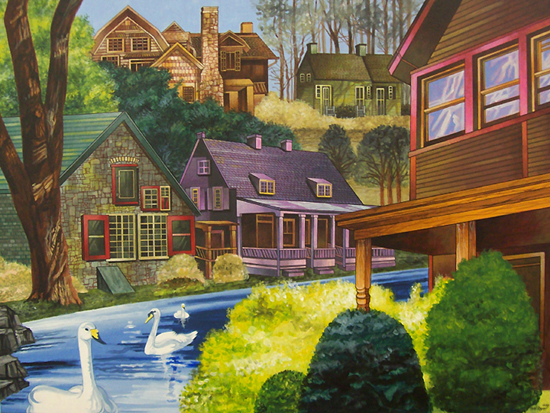
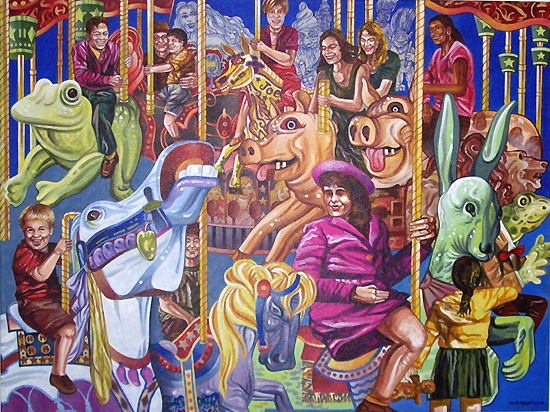
But, undoubtedly, I found "Lower East Side: 1942: Menachim Rubin Sells His Pretzels" to be the most incredible of Rogoff's paintings on display until December 29, 2010 at the Library Gallery. Mr. Rogoff dates his painting "1942" but could this not be the New York's Lower East Side of "2010" as well? Aren't there still independently-owned zipper, sweater and pant shops up and down New York City Lower East Side streets and signage that may still read "Streit's Matzos," and "Myron's Hats?" And as is portrayed in the lower left of the painting, aren't there still handsome industrious Jewish men in poorboy caps selling their produce and wares and long white-bearded rabbis walking the street with exactly the same concerned expression? And as is portrayed in the right side of the painting, aren't there still Jewish grandmothers with that same warm and forgiving smile...and doesn't that white-haired lady look precisely like the one you almost bumped into last week when you were in the City when she flashed you that smile?
And, so it is that Mr. Rogoff presents images that are so classic and relatable that the painting is almost timeless. In presenting "The Way it Used to Be and Now," we find that at least when it comes to portraying the New York experience and the Jewish culture and influence there, things are really not all that different. Perhaps, it is Mr. Rogoff's commentary on the remarkable resilience and appeal of the Jewish people...a people so deeply rooted in tradition, with such strong family bonds and an equally strong work ethic that life on New York's Lower East Side is much like French writer Alphonse Karr's proverbial saying "the more things change, the more they stay the same."
But, perhaps we should ask Mr. Rogoff directly about what he intended in this painting and it certainly wouldn't be difficult to do so. For as much as Mr. Rogoff is described as a "polymath of art," he is not unlike his favorite comic book hero, Stan Lee's "Spiderman," a superhuman who is still very human and very humble.
Thanks again, Johnes, for another class act,
Donna Marie Joyce
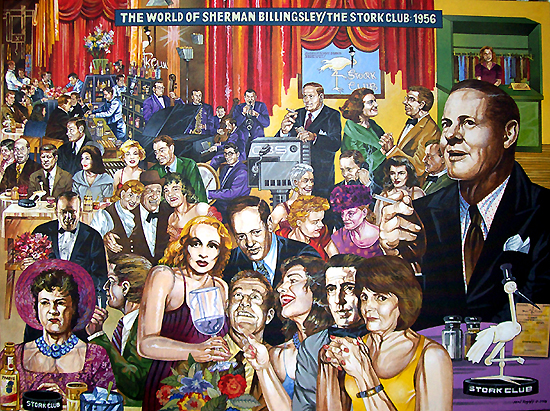
Nearly everyone can recall a staircase or two they have descended perhaps into a cocktail party or niteclub where lights are dimmed. But, what makes John Favret's painting "The Stairway" ominous for this viewer is that when one leaves the well-lit stairs, things seem just a bit too dark. One could almost discern the top of people's heads in a crowd but you can't discern figures in this degree of darkness. And so, I felt to be just a couple stairs above the person in the painting descending those stairs. Perhaps just enough time to turn around and get out of there but, in any case, definitely activating my "fight or flight" response.
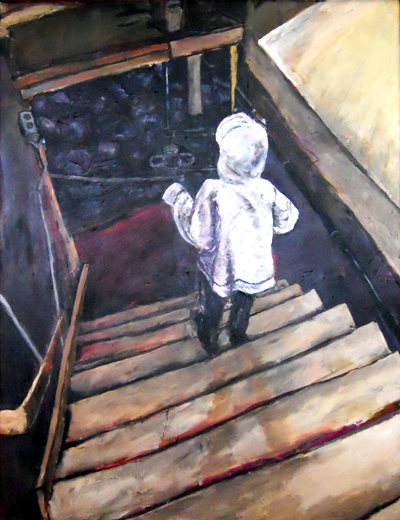
In "Crapshoot" (60" x 52" acrylic on canvas), one need only take a quick ride to the local casino to know that Favret has captured the essence of the gambling experience. From exultation and pure euphoria, to fear and desperation, to overstimulation and then to numbness and disconnect how one feels is a consequence of where he or she is in the game...not unlike the game of life itself. And the "viewer as participant" is a part of the palatable energy.
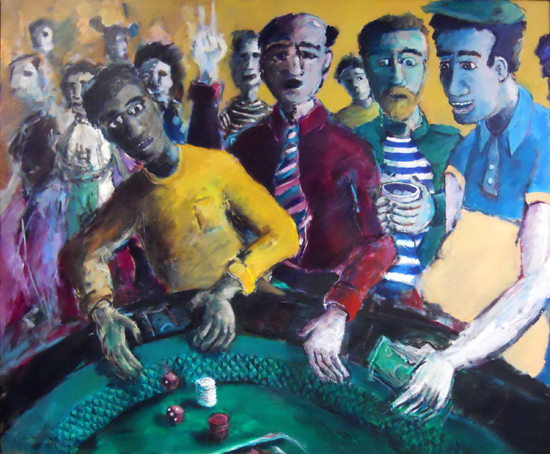
Interestingly, it is the City that is the backdrop in "The Story Teller" (52" x 60" acrylic on canvas). The story teller continues "to spin yarns" whilst the listeners seem resigned and another at the edge of the painting seems to be running fervently to escape the story teller's milieu. The affect is almost humorous as everyone has been part of a conversation from which he or she has wanted direly to escape.
But, what is so interesting about "The Story Teller" is that in the macrocosm of the City it is this microcosm of a few individuals that takes Favret's concern. The importance of the individual is elevated and certainly makes the point that we all have a story to tell even if it is not a story all want to hear.
In the City of New Haven, Mr. Johnes Ruta as curator of Azothgallery, has provided for many artists' stories throughout the years whether tucked away in the York Square Cinema's gallery or the New Haven Public Library's lower level gallery. And thankfully, each and every exhibition has been a story worth the listening.
Cordially, Donna Marie Joyce
"Deer" is a story of teen-age hi-jinx during the Vietnam War period, one of the youths' uncle a colonel, while the banter of sarcasm, half-hearted rebellion, and coming-of-age hormones rage and perplex one ostensible young couple. In "String" a thirty-something wife struggles to clean the home they are about to move into, struggles with her religious scruples and icons, and with her suspicions of her husband's whereabouts.
In "Remember Hardy," the authors effectively switches gender, getting inside of the husband of a middle-aged couple socializing with their house neighbors on both sides, most closely with his friendlier neighbor's alluring and startling intuitive foreign wife. The narrative provides insights to the man's emergence of his subliminal sensations, the wife's intuitive awareness, the point-of-view of an involved observer.
In "Blue Skies" the narrator finally emerges as the young gay male spending the summer with his lover who has inherited a beach house in East Hampton. A cast of young friends populate each color-coordinated bedroom: another happy and secure gay couple, young-women twins, all quietly enjoying the summer. And then suddenly, a French girl with yapping poodles arrives to sleep with his boy-friend. As the new arrangement is manifested, one feels the immanent and deepening heart-break...
The married, middle-aged psychotherapist in "Help" wrestles in his own battle between his super-ego, ego, and id, over his suppressed lust for a beautiful patient.
And in "Within You Without You" and "Elvis in the Meditation Garden" are convincing, fascinating first-hand accounts of an sexy and attractive, thirtyish young woman traveling with the Beatles in India to live in the Maharishi's commune, and again as a concert organizer helping a suddenly resurrected Elvis prepare for his "come-back" concert....
Indeed, having first heard the former of these two stories read by Susan Tepper at a poetry reading in Washington Heights, I was convinced -- perhaps still -- that this was a privileged personal memoir. Each of Tepper's narratives has a ring of reality to it, visually well-described though hovering on the edge of it, seamless and compelling story-telling !
"Deer &
Other Stories" by Susan Tepper (2009, Wilderness House Press)
Reviewer: Johnes Ruta, independent curator & art theorist
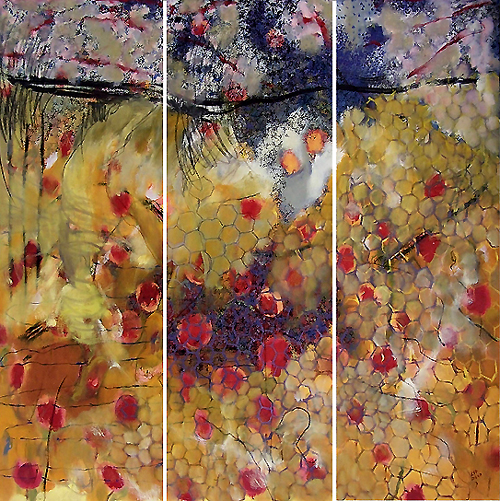
As I entered the exhibit, I first encountered "Still Gathering/Enough" (50" x 68" oil on canvas, 2007), an oil on canvas triptych. Before my eyes could comfortably settle upon some of the more restful colors in the first and third panels, my eyes shifted to what appeared to be a face which manifested in the mid-panel bearing jaundiced eyes...and one could sense the darkness and struggle coexisting amidst the pinks and muted landscape of the panels.
Against the far wall, I experienced "Flowershells & Honeycombs," (60" x 63" oil on canvas, 2007), another oil on canvas triptych. The dimension and texture of this painting up close is remarkable. Through the layering of paint, I really got a sense of the expiration of time...as the black especially appeared to have been applied at the very last, I sensed that time itself was responsible for bringing "struggle" and "contradiction" to this otherwise restful and fluid place where flowershells and honeycombs did abide.
And, indeed, in "Blown Through," (60" x 65" oil on canvas, 2009), an Orjuela diptych, the "disruption" and "disconnect" is achieved sequentially. Whereas in the first panel, the birds appear upright, I found their fate turned upside down in the second panel where the glass is "blown through."
In "Milonga in Violets," (12" x 16" oil on canvas, 2001), light and the figure's connection to the earth really seems to prevail but for the deep red/maroon that lurks at the figure's back...And even in "Abandon," (12" x 16" oil on canvas, 2001), although we see a female nude figure in repose, dark maroon circles and streaks surround the figure seeming to manifest the possibility of "disruption" and disquietude and we cannot fully "abandon" our thoughts to the figure alone.
And, this is what I find so remarkable about Orjuela's paintings. Whether the "disruption" or "disconnect" is achieved through layers and layers of paint or whether the "disruption" or "disconnect" is achieved sequentially over a course of two or more panels, "the world of paradoxes" is never far away...and whether it consistently coexists in each and every life situation or whether it merely lurks on the horizon is perhaps a matter of personal interpretation but the struggle is ever present and brilliantly captured in Orjuela's oeuvre.
Thank you again, Johnes, for introducing another high calibre artist. As an artist and art lover, who has followed most of your shows from the old York Square Cinema to new spaces including the New Haven Public Library, I am ever thankful for how your sophisticated eye has kept the New Haven art scene fresh and new.
Cordially,
Donna Marie Joyce
by Donna Marie Joyce
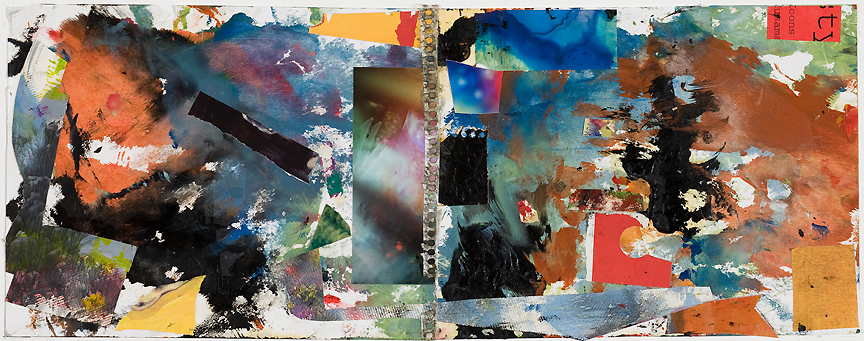
Nonetheless, I did stop by to view the Dr. Felix Bronner exhibit this past week. As usual, it was another inspiring set of works. I noted a palpable feeling of particles/ matter/ energy in all of the works. With the restful and calming primary color of seafoam green, “Seascape” was a great way to start the exhibit. “Roaring Over Print” is fantastic to me – it’s an apt metaphor these days for my state of mind, and equally well depicts my office space.
Finally, I enjoyed “And What Can You See?” .. I’m still not precisely sure what I did see .. Every time I glanced at the work during my short visit, the experience was different – but it was a great adventure!
Hope to see you in 2010! Thanks again for continuing to include me on your art opening invitations list.
All the Best,
Donna Marie Joyce
November 16, 2009
-- essay by Ellen Hackl Fagan
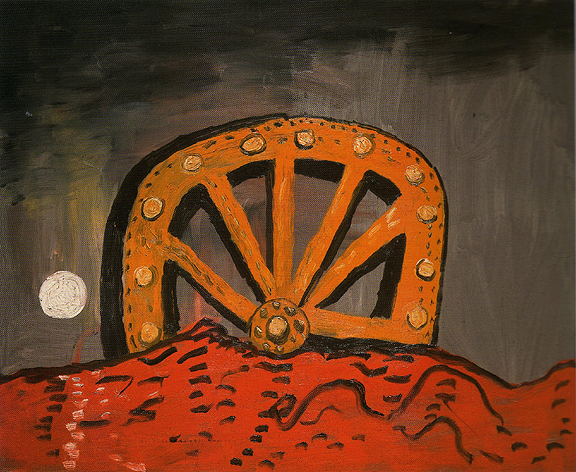
In Guston’s later works we see his self-portrait emerge as a Sad Sack, schlumping along the surface of the earth, his stubbly bandaged face,his Cyclopean stare. His gaze sees his world, his problems with himself and with the act of painting. He also looks at the problems in our world in its time. If you’ve ever painted or struggled with creating something, Guston’s hand will tear at your heart. Gooey, thick pink blobs, peach and red, crudely rendered black lines and tan mushy, gushy paint resists casual flow and shows us that the artist has been humbled in making his mark. I could wear his reddened paint as a skin, or I could dive into its viscous depths, traveling to the internal workings of his all-too-human heart. It’s his self-portrait, but it speaks to anyone who has ever felt like that Sad Sack, unable to ignore the siren’s call of paint and surface, to attempt transforming the intangible into the palpably tangible over and over again.
Guston’s Everyman is a trusted observer, reporting on the way it feels to question one’s own abilities as well as the authorities in charge of our lives. Fearlessly honest about his position in this life, underwhelming on the outside, this grubby, stubbly man goes along unnoticed and unhampered. We are invited to take the journey with him, through the course of his ugly, raw paintings. To paint about the life of Everyman, and possess an ounce of truth, we have to submit to showing it’s ugly side. Guston shares the company of history’s heavyweights: Hugo, Goya, Bosch, Joyce, Bukowski and Kerouac. We know his Sad Sack to be, atleast in some small way, ourselves.
As Guston’s paintings evolved, the self-portrait externalized and became more universal. Symbolism is the way to abstraction and Guston’s Everyman became a Wheel. After working my way through his oeuvre at the Met years ago, the last canvases stopped me cold. The simplicity, the palette – born of flesh,blood and bone, and his beating heart, rang so true that I couldn’t stop my tears. These canvases, printed themselves upon me and gratefully, have never left my memory, still remaining powerful and immediate.
That wheel was going “home.” Guston suffered from a near heart attack that same year and death was a question he undoubtedly explored. The sky is darkening in this painting. The wheel is monolithic, its rustic bolts and crude wooden construction heavily outlined in black. The rough wood glows yellow (like a halo?). The moon rises to the left of the half-buried wheel from the horizon line of a deep scarlet earthen road (or is that a turbulent sea?). The moon rising is reminiscent of mythology. The reflection of the moon on the earth/sea surface shows us the path to the Underworld or the Spirit World or redemption. It signals that death is imminent.
Going “home” might entail a final judgment before God prior to being granted entry into Paradise. “Home” is the place to die and put the earthbound body to rest. The Wheel is a timeless metaphor every tribal storyteller, shaman or folk musician has passed down. Through Jerry Garcia, Johnny Cash, mountain music, gospel songs and spirituals, and eastern religious practices, The Wheel of Life keeps turning. No one can get off; it keeps going ‘round. The fact that Guston evolved in his painting to the point where he, too, entered that storytelling tradition shows anyone brave enough to look with an unblinking gaze, that “home” is very real, very true, and that we, too, will one day be that Wheel. Slowly turning, revealing its face to the viewer, resolute in its direction with the moon rising in the horizon, half stuck, no longer able to hide flaws, like Guston,we are on a path to “home.”
Ellen Hackl Fagan
efagan4@optonline.net
in painting
Creative writer; Independent curator, since 1988.
Art Director New Haven Free Public Library.
To preface an understanding of his new work, Mr. Boborelu had sent me an outline and diagram of the 5 Buddha Families and the 5 Realms of Samsara, representing the transcendent, brilliant, & compassionate states of Mind and Reality . . .
In a large diptych of four fitted panels in black and white only, totaling 8 feet high by 12 feet wide, Boborelu has created what I’d describe as a "geometric object field” : a painting in which black fractal objects on a white ground vibrate beyond the visible animation of objects into a deep spiritual contemplation. These forms capture a momentary / instantaneous Space / Time Continuum.
In another painting, measuring 40" x 40", flowing currents of bright red, green, yellow, and blue paint move diagonally downhill across the canvas from upper left to lower right. This motion seemed to create a flowing bridge of colored space which juxtaposed this piece and the diptych together.
The sensation of this bridge connected over a kind of open space, and this space seemed to occur in the time frame between my initial impression of the artwork and the moment in which the smaller painting then carried me into the threshold of a Buddhist state of Contemplation. This sensation then proceeded to a second threshold, in which the black and white fractals and the colored animation took on an energy of Matter, such as a vision of the conception of Life.
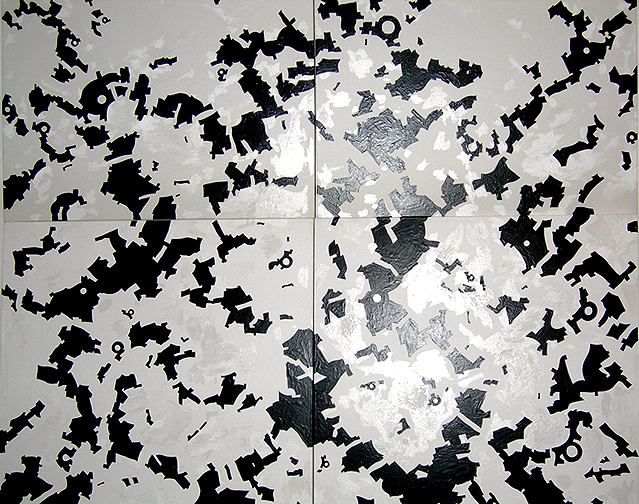
~ Johnes Ruta, independent
curator
New Haven, CT
October 18 - November 23, 2008. Published 11/24/2008.
Review written by Johnes Ruta, 22 Willard Street, New Haven, CT 06515
Creative writer; Independent curator, since 1988. Art Director New Haven Free Public Library.
http://azothgallery.com/
azothgallery@comcast.net
Even at mid-day, only faint eastern light filters into the store-front windows of the Gallery RIVAA from the Roosevelt Island city street, even further remote behind low embankment seating of the showcase area. But the interior space is moreover a comfortably-lit complex of open and long rooms, ambient walls, and display spaces both wide and narrow.

"Mists of Burgundy," "Corn Field in November," and "Nocturne -- Queady Lake, NY," visible strokes of the artist's pastel brush upon white paper provide a subtle undertone which seeps into the viewer's consciousness rather as reflected surfaces of light.
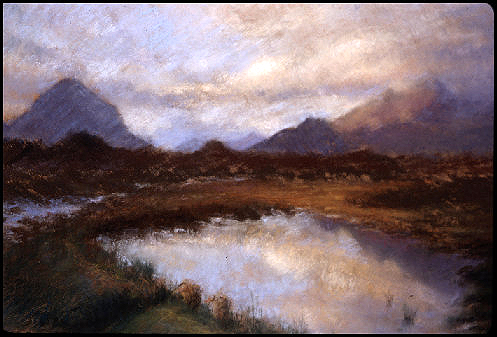
In "Passing Storm, VT," green lake water reflects the lavender twilight sky, soft and cloudy; the landscape recedes from detailed perspectives into unfocused distant horizons of blue and turquoise mountains. In "Pasture," a S-shaped bright green field curves between dark green woods along both sides.
Ms. Sinclair, also an Audiologist, was a 1980's émigré from Romania. She says that she is fascinated by the beauty of nature and finds poetry in scenes which express a mood by freezing a moment. Indeed, her landscape expressions capture the moods and fragments of time.
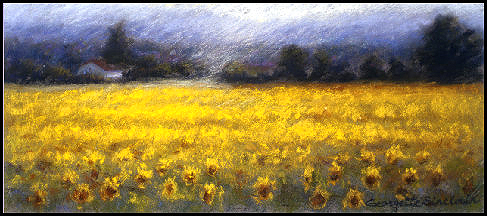
The following is an essay by Dr. Janice E. Patten, University of San Jose'
http://www.sjsu.edu/faculty/patten/sublime.html
This URL is linked as a literary resource on AzothGallery.com
and precipitated a series of philosophical Comments which follow.
Longinus: "On the Sublime"
Longinus, writing in the classical historical tradition says that the sublime implies that man can, in emotions and in language, transcend the limits of the human condition. Longinus's approach is contradistinguished from Plato's declaration of poetic inspiration as dangerous divine madness or the poet as liar. Yet like Plato, Longinus feels that the human was the art or technical aspects, while the sublime was the "soul" or that which eluded our experience of art. In order to understand the sublime, we must have some notion of what exists beyond the human, empirical experience. Longinus explains that this "beyond" is comprehended in terms of metaphor, or in terms of what is absent from the empirical world. Our sense of the sublime is an illusion, which draws the reader to new heights, to the realization that there is something more to human life than the mundane, the ordinary. In fact, the sublime entails a kind of mystery. The sublime is that which defeats every effort of sense and imagination to picture it. It is that whose presence reduces all else to nothingness. It can be defined and described only in symbolic terms, which ironically defies the pictorial arts to sketch it. It remains only for the art of the metaphorical language of poetry to give the suggestion of the sublime.
Longinus's contribution to conceptions of the beautiful/sublime also includes the poet's "joining" with this vision of greatness. We gain a greater sense of freedom, by our sense of our capacity to join in this greatness. Hence when we speak of Longinus we think of verbs such as "transport," "transcend," "awe-full," "flight," "amazement," and "astonishment." One particular quotation summarizes this idea: "For, as if instinctively, our soul is uplifted by the true sublime; it takes a proud flight, and is filled with joy and vaunting, as though it had itself produced what it has heard."
Longinus centers also on figurative language, discussing the great writers of the past and their importance, our "possession 'by a spirit not one's own. . . . The genius of the ancients acts as a kind of oracular cavern, and effluences flow from it into the minds of their imitators." He holds Plato up as a model and an ideal of great literature, thereby answering and defending Plato's style against his critics. The decline of letters in his day is due not to despotism, but slavery to pleasure and greed. He shows us that great thoughts have been uttered by men of the past and can be uttered again. Sublimity becomes, for him, the source of the distinction of the greatest poets and prose writers, something like a thunderbolt that could strike anywhere. Because of his belief in sublimity, he also believes in the privileging of mental processes. He holds in an almost mystical way that the composer is identified with what he describes; and because of the excitement of the moment of inspiration, the hearer or reader is also a participant in the feeling of sublimity. And so it was that Longinus first brought passion and the concept of readerly complementation to the study of literature.
Edmund Burke: "A Philosophical
Inquiry into the Origin of our
Ideas of the Sublime and Beautiful
Burke is clearly in the debt of Longinus, but his fundamental orientation is different. Drawing from the empiricism of John Locke, Burke assumes all our knowledge comes by way of sense experience, combing simple impressions into more complex ones. Imagination, for Burke, is more closely aligned with Coleridge's conception of "fancy." It operates in two ways, by "representing at pleasure the images of things in the order and manner in which they were received by the senses" and by "combining those images in anew manner, and according to a different order." Therefore, according to Burke, the imagination cannot create anything "new"; it can only reorder and combine basic sense perceptions.
More important than taste are distinctions involving the sublime. The sublime applies to large, grand parts of nature while the beautiful is evident in small parts. In addition, Burke associates the fear of death, dismemberment, terror, and darkness (e.g., a howling wilderness) with feelings of sublime. Locke does not think that darkness is sign of terror, but Burke feels an association of utter darkness makes it impossible to ascertain one's safety, sensing immanent danger evokes a feeling of the sublime. He sees a difference between what the mind expects and what occurs in any given situation. Part of his thesis involves the fact that fear robs the mind of reason, hence evoking the sublime. He says:
Whatever is fitted in any sort to excite the ideas of pain, and danger, that is to say, whatever is in any sort terrible, or is conversant about terrible objects, or operates in a manner analogous to terror, is a source of the sublime; that is, it is productive of the strongest emotion which the mind is capable of feeling. I say the strongest emotion, because I am satisfied the ideas of pain are much more powerful than those which enter on the part of pleasure.
In Burke's terminology, the "passions which concern self-preservation, turn mostly on pain and danger" (55). To make circumstances appear terrible, however, obscurity is necessary. "All privation is great because they are all terrible: Vacuity, darkness, solitude, and silence. Low and intermittent sounds and shadows bring about feelings of the sublime. Above all, the actions of the mind are affected by the sublime."
Sir Uvedale Price considered the nature of the sublime, but argued in a line consistent with ideas of the picturesque.
Kant says that sublimity does not reside in anything of nature, but only in our mind, insofar as we can become conscious that we are superior to nature within, and therefore also to nature without us (so far as it influences us). Everything that excites this feeling in us, e.g., the might of nature that calls forth our forces, is called then (although improperly) sublime. Only by supposing this idea of the sublimity of that Being which produces respect in us, not merely by the might that it displays in nature, but rather by means of the faculty which resides in us of judging it fearlessly and of regarding our destination as sublime in respect of it. ("Of the Dynamically Sublime in Nature"; Adams, Critical 396). In Kant, "the mind feels itself set in motion in representation of the sublime in nature; this movement, especially in it inception, may be compared with a vibration with a rapidly alternating repulsion and attraction produced by one and the same Object. The point of excess for the imagination is like an abyss in which it fears to lose itself." ("Analytic of the Sublime" 107, qt'd in Thomas Weiskel's The Romantic Sublime 105)
Wordsworth on the sublime and the Beautiful: in speaking of seeing the mountains of Langdale pike--
Let me then invite the Reader to turn his eyes with me towards that cluster of Mountains at the Head of Windermere; it is probable that they will settle ere long upon the Pikes of Langdale and the black precipice contiguous to them. If these objects be so distant that, while we look at them, they are only thought of as the crown a comprehensive Landscape; if our minds be not perverted by false theories, unless those mountains be seen under some accidents of nature, we shall receive from them a grand impression, and nothing more. But if they be looked at from a point which has brought us so near that the mountain is almost the sole object before our eyes, yet not so near but that the whole of it is visible, we shall be impressed with a sensation of sublimity.--And if this analyzed, the body of this sensation would be found to resolve itself into three component parts: a sense of individual form or forms; a sense of duration; and a sense of power. . . . A mountain being a stationary object is enabled to effect this in connection with duration and individual form, by the sense of motion which in the midst accompanies the lines by which the Mountain itself is shaped out" (351-2). . . .Individuality of form is the primary requisite; and the form must be of that character that deeply impresses the sense of power. And power produces the sublime whether as it is thought of as a thing to be feared, to be resisted, or that can be participated. To what degree consistent with sublimity power may be dreaded has been ascertained; but as power, contemplated as something to be opposed or resisted, implies a twofold agency of which the mind is conscious, this state seems to be irreconcilable to what has been determined, exists in the extinction of the comparing power of the mind, & in intense unity.(356).
"Imagination . . . so called / Through sad incompetence
of human speech" (Prelude 6.592-93). Human sight rises in intensity
from memory through salience tot he occlusion of the visible. Imagination
also rises "like an unfather'd vapour" to target man's fight
to remain autonomous and self-reliant.
Paul Szemanczky wrote:
I discovered Janice Patten's "Sublime" essay linked from your webpage and want to tell you it is incredible. Edmund Burke comes off dark and brooding, as if he were searching like Hans Gunther for "the Nordic" man, some Aryan strain of perfection.
One of the books left by my late father, Jules Szemanczky (1926-2008), was a 1947 text from the New Haven State Teacher's College, a beautiful, huge volume of English poetry, which must have been one of the courses he took. I was always enchanted by it, especially the Romantics. The Lyrical Ballads (Prelude) of Wordsworth particularly ringed true for the two of us, Dad and myself. Janice Patten's description of the mountains of Langdale Pike as seen by Wordsworth ring true with my actual vision yesterday from 850' feet high on Goat's Peak's watch tower inside Connecticut's Mount Tom State Reservation park.
Dad would have loved Patten's closing: (Wordsworth) "Human sight rises in intensity from memory through salience to the occlusion of the visible. Imagination also rises "like an unfather'd vapour" to target man's fight to remain autonomous and self-reliant.
Our whole society seems to be bending opposite the Wordsworth's treatise towards co-dependence, impersonal social-engineering, and ulterior (state) regulation, all Wordsworthian anathma. I wish Dad could have read Patten's paper, he would have loved it. I gave him oncea condensed text of Schopenhauer's, and in his Marcus Aurelius fashion, he devoured it and found many threads of salvation. Eternal optimist, yet truly Stoic, was he.
Take Care,
Paul
AzothGallery wrote:
Dear Paul,
Thanks for your messages and for your fascinating take on Janice Patten's
essay on The Sublime linked from my website !
Your email discussing "The Sublime" has sparked my brain to
revisit the ideas and attitudes of Edmund Burke (1729-1797), and his near
contemporaries such as Immanuel Kant (1724-1804), and his personal friendship
& later philosophical/ political combat with Tom Paine (1737-1809),
about whom I've just finished listening to Christopher Hitchen's biography
on Paine "The Rights of Man" narrated by Simon Vance. Now I've
embarked on more serious research on their connection, and to understand
Paine's literary influences.
Indeed your take on Burke rings true with me -- and while Paine didn't
theorize on Art or Aesthetics, his philosophical arguments tested the
Whig MP Burke, and eventually showed up the limits of Burke's Empiricism
as a follower of Locke and how knowledge is derived from sense experiences.
Both were Quakers, and from early on, Burke was a supporter of the American
colonists campaign for independence; in the 1780's Burke became a muckraker
against corruption in the rule of the new colony of India. But when the
French Revolution broke out he also vehemently opposed to its overthrow
of the monarchy, and fretted that the Jacobin frenzy would spread to England.
I'm not yet clear how much Tom Paine was influenced by Thomas Hobbes and
his concept of the Leviathan as an allegorical description of the State
as a serpentine organism winding its way through the Labyrinth of rich
and poor streets of London, but it is clear that Paine was strongly influenced
by Jean-Jaques Rousseau "Man is born free, but is everywhere in chains..."
-- But as an avid reader Paine would have known that the very concept
of the "Social Contract" had been invented by Hobbes ("Life
is short and brutal"). For Burke, Hobbes grasped the positive meaning
of the benevolent monarchy. He is known to have detested Rousseau, and
believed that England "had already had its Revolution in 1688"
when then Catholic Stuarts were disposed of. From then on, all the King's
subjects "knew their proper place in society..... " high or
low....
Tom Paine was a free-thinker as a youth in Thetford, England, and attempted
to run away to sea at 16 to escape his father's corset-making business.
He instead became a customs agent, then a pamphlet-writer for local unionizers.
His friendship with a London mathematician and astronomer who was a friend
of Ben Franklin led to getting him to Philadelphia in 1774, where he wrote
pamphlets for the revolutionary movement, and befriended Lafayette during
the war.
After reading Burke's 1770 "Thoughts On the Present Discontent",
Paine had sent him his own "Common Sense." Burke responded personally,
and on Paine's return to England took him on a tour of the countryside
to find a site for Paine's design for an iron bridge. Paine's friendship
with Lafayette concerned Burke about the "spread of the American
Revolution" and it's first democratic government back to the Continent
and possibly to England. Paine's continuing pamphlets soon got him in
hot water, and the PM William Pitt issued a warrant for his arrest for
Seditious Libel. Apparently warned at a party by William Blake that he
was about to be arrested and possibly killed, Paine immediately left for
Paris to take up Lafayette's invitation, and soon became involved in the
Revolutionary Council where he argued that France, being the first country
to abolish monarchy, should also be the first to abolish capital punishment
as a holdover of medievalism .... His faction was outvoted and he soon
was arrested on the orders of Robespierre.
About the sense of "The Sublime," I concur more with Longinus
(it is historically unclear who he was and in what time-period he lived,
evidentially 1st or 3rd century) . A new link for Longinus (just added
to my "Arts Critiques" page):
http://en.wikipedia.org/wiki/Longinus_(literature)
The word "sub-limis" itself means "below the Threshold"
and for me that has always been experienced as a sense of the awesome-beautiful
-- a profound stillness -- or sense that something has entered beneath
my conscious "radar" and then powerfully transfixed me in Time.
In this sense, there is the sense of awe, a powerful element not of Fear,
as posed by Burke, but of immensity, great or subtle events of Emotion,
Love or Compassion, which brings us to tears with the sense of the profound.
In Wordsworth, Jacob Bronowski's brief quote from "Lines Above Tintern
Abbey" comes to mind, in the Enlightenment of the experience of the
Natural World, witnessing the tremendous power of a water-driven energy
canal :
When like a roe
I bounded o'er the mountains, by the sides
Of deep rivers, and the lonely streams,
Wherever nature led: more like a man
Flying from something that he dreads than one
Who sought the thing he loved. ---- NATURE THEN
TO ME WAS ALL IN ALL. I cannot paint
What then I was. The sounding Cataract
Haunted me like a passion.
(I've always remembered this as "All in Awe..."
Or as William Blake put it in his own terms:
Energy is Eternal Delight !
I love to discuss philosophy and look forward to working with you on Jules'
Memorial show ... !
Best Regards,
Johnes
by Carl Pfluger
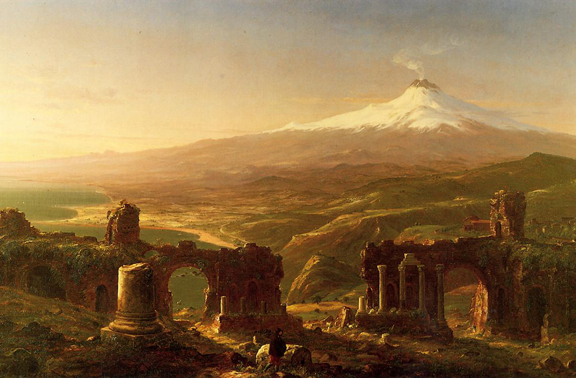
But hardly less phenomenal than the scale of Cole's reputation during his life was its steep and sudden decline shortly after his death. (I can't help feeling that Cole himself would have derived some melancholy enjoyment from this, pre-occupied as he so often was with spectacles of the transience of human accomplishment.) He was, to be sure, never completely forgotten; but in respectable opinion Cole's work was soon taken seriously in only one of its many facets - the "pure" landscapes, especially of "wild" scenes - and even these were often treated with a patronizing benevolence not far short of contempt. As for the paintings dearest to Cole's heart -- the religious allegories, the historical epics - they were dismissed or ignored as an embarrassment, just the kind of faux pas likely to be committed by an awkward bumpkin unaware of the true nature of his own genius - or of his proper station in life. By the beginning of this century the 11th Edition of the Encyclopedia Britannica, that priceless repository of Late-Victorian wisdom, summed up the prevailing view of Cole's "higher style" thus:
"The work, however, was meretricious, the sentiment false, artificial and conventional, and the artist's genuine fame must rest on his landscapes, which, though thin in the painting, hard in the handling, and not infrequently painful in detail, were at least earnest endeavours to portray the world out of doors as it appeared to the painter; the failings were the result of Cole's environment and training."
Of course, none of the modernisms that emerged in the second half of the nineteenth century and the first half of the twentieth had much use for the programmatic, narrative or illustrative dimensions of painting, tending to view them as a kind of contaminant to the purely formal, and increasingly abstract, visual or "painterly" elements. So it is understandable that Cole's reputation suffered from this change in the climate of artistic fashion, because he always was, in the manner fashionable in his own time, a thoroughly literary painter, who always assumed that the visual arts refer to some range of concerns beyond themselves - and who had no problem, by the way, in sometimes addressing those concerns in writing as well as in painting. As recently as 1962 James Thomas Flexner clucked disapprovingly over Cole's "dangerous literary gifts" - as if he would have been a better painter had he been illiterate, a kind of idiot savant!
But more recently, fashions have been changing again -- is this one of the more beneficent effects of post-modernism? - making possible some steps toward rehabilitation. The most recent of such steps (and probably the biggest so far) is Thomas Cole: Landscape into History, a major exhibition organized at the National Museum of American Art in Washington, DC by William H. Truettner and Alan Wallach, displaying about 70 of Cole's paintings and accompanied by an illustrated catalogue (more useful and informative than such publications often are) including essays by J. Gray Sweeney, Christine Stansall and Sean Wilentz, as well as by Wallach and Truettner themselves.
This exhibit is especially welcome because it makes a serious effort to get beyond that conventional wisdom of the past century or so, and to consider all facets of Cole's work with a more integrated and comprehensive view - closer at least to the painter's own intentions. Wallach, Truettner and their colleagues have also done much to place Cole in his social, political and cultural context in early nineteenth-century America. Their particular interpretations here must still be regarded as limited and tentative - no single formula could encapsulate so protean an artist as Thomas Cole - but there is no question, I think, that they are on the right track in trying to re-integrate "the two Thomas Coles" (as Professor Truettner titles his essay) and in taking Cole seriously as that rarity of the modern world, an artist who actually thinks: about nature and history, life and literature: about humankind and its place in the world.
And as for how all that thinking inflected Cole's work as a painter - well of course, some of his works are technically better than others, and some are more derivative than others; and yes (the conventional wisdom was right to this extent) he developed his most original insights by working closely with some of the particular features of American scenery - features which were then still largely new to European eyes - but then going beyond this, he applied that insight to something both wider and deeper, developing (to invoke a pair of Cole's own favorite terms) a historical "vision" as well as a painterly "view." And that, one might say, is what landscape art, in its most authentic sense, is always trying to be about. For although landscape may sometimes seem to be a naive genre of painting, in reality it is not. Historically, both in China and in Europe (the only two cultures so far to have fully developed landscape at all) it arose very late in the artistic tradition. Only after many centuries of representing more or less distinct individual figures did people begin paying serious attention to the background in which those figures were placed, to the connecting spaces between them: in short, to their total environment. And it seems probable that such developments always depend on, but in turn contribute back to, parallel developments in such other fields as science, philosophy, religion, history and literature. In China, where painters were at least officially expected to be literati, a relation between landscape painting and both religious and philosophical Taoism, for example, has long been taken for granted. In the West (where of course our whole landscape tradition is much younger) such connections have been more problematic; but it is helpful to keep them in mind when trying to understand Thomas Cole, who was so passionately (and sometimes profoundly) religious, literary, and historically-minded a painter: in all of his work, even the most superficially "naive" of his wilderness scenes.
No, there were not
"two Thomas Coles"; but there is an unresolved duality within
Cole himself, and within his work: a division too glaring to be ignored.
Toward the end of his own essay in the catalogue Professor Wallach approaches
this division, rather diffidently, when he writes:
" . . . if a fault line runs through Cole's art, it lies between
the historical and the ahistorical, between the landscapes and allegories
that in a more or less
fragmentary way evoke the stages of history and 'mutation of earthly things'
and the religious allegories and related paintings. Yet even this division
is in
a sense unnecessary since, as we have seen, the historical and the ahistorical
were themselves closely connected.."
I would put it rather differently. Virtually all of Cole's work is historical; but the difference between, say, The Course of Empire and The Cross and the World is between "natural history" and "supernatural history" - what German theologians in the nineteenth century were already beginning to call Heilsgeschichte ("the History of Salvation") and which they represented as the central theme of all Biblical religion. Another way of describing this "fault line" might be to say that his work was always religious - but that Cole actually believed in (or at least tried to believe in) two different religions at the same time. Christianity (to which, given his own historical origins, Cole could scarcely escape having at least a nominal commitment) co-existed in him with his personal version of that fully religious reverence for Nature which he seems to have believed in most strongly - which has actually been around, in one form or another, a good while longer than Christianity itself, but which was just re-emerging with special force and intensity in Cole's own Romantic period - and which was the real source of Cole's strength and originality as a landscapist.
I'm not sure how conscious Cole was of the tension between his two religious loyalties - my suspicion is that he could not admit it to himself, and kept trying, out of a dogged sense of duty, to impose his familiar but somewhat shop-worn Christianity onto his more impassioned but less articulated Naturalism - but its effects show, often quite painfully, in his more didactically Christian pictures. Few things in the history of art can be more literally excruciating than those crosses glowing like neon signs in the desert -- a "prophecy" come literally true in our time, which Cole, had he lived to see it with his eyes of flesh, would certainly have abhorred! - or those insipidly phosphorescent figures of Christ and of angels (anemic, attenuated derivatives of Raphael and his successors, the bane of so much post-Renaissance Christian art . . . ) which seem to have dropped down like aliens out of a UFO (often accompanied by unnatural laser-like light effects) into an otherwise passably naturalistic landscape in such paintings as The Pilgrim of the Cross at the End of his Journey, or the Angels Ministering to Christ in the Wilderness. Of course one could always argue that such gauche intrusiveness is a respectable artistic convention, meant to suggest the absolutely transcendent and supernal power of the Divine; but such an argument would have already conceded the most important point: that at least in its symbolic language, Cole's Christianity is always referring ultimately to some source of value which does not co-exist comfortably or harmoniously with anything we can readily recognize as "nature", that is, with the world as we know it on Earth. And it could also be argued that much of the awkwardness in these Christian paintings results from a much simpler and more technical cause: Cole's notorious weakness in handling the human figure. It is true that his figures are often inept; but not uniformly so. Generally they are at their worst when Cole seems not to have a clear sense of how his humans fit naturally into their surroundings, when he just sticks them in for more or less clearly arbitrary and symbolic purposes. He sometimes did this even in his "pure" wilderness scenes. (Truettner and Wallach give one especially egregious instance of this: when Cole painted The Falls of the Kaaterskill in 1826 it was already a busy tourist attraction, with the usual clutter of hotels, walkways and protected bridges overlooking the Falls. Cole omitted all that from his painting; instead, he placed a solitary Native American in the scene. This poor Indian is stuck there, quite awkwardly and unaesthetically, leaning against his bow on a bare ledge right in the middle of the painting. Clearly, he serves here only as a self-conscious sign or label, as if one had written a caption: "THIS PICTURE REPRESENTS AMERICA BEFORE THE WHITE MAN".) But cases like that are extreme, and rare. Cole's level of technical accomplishment varied considerably from time to time, but he could and did paint human figures credibly enough when he had reason to: when this was clearly demanded by his conception, and supported by what we would call the "human ecology" of his design.
In his Arcadian pastorals, for instance, human beings (and their artifacts) tend to fit happily into their natural settings. These pictures probably represent Cole's most Utopian vision, the clearest personal declaration of his idea of the Good Life, the True and the Beautiful. For although Cole fully deserves to be recognized as one of the nineteenth century godfathers of the modern environmental movement; although he genuinely loved his wilderness scenes, and certainly contributed largely to that positive re-evaluation of the very idea of "the wilderness" which (in such contrast to the Biblical attitudes of dread and hostility) has been one of the great revolutions in values accomplished over the past couple of centuries; still, Cole would not have qualified as an "environmental extremist", even by the most polemical of definitions current today. He did not assume an irreconcilable antipathy between "Man" and "Nature"; he had none of the misanthropy that sometimes infects the wilder fringes of Deep Ecology. Wallach and Truettner characterize his general attitude as "pessimist conservatism", which is fair enough as far as it goes; but it really doesn't take us very far toward understanding the deepest ranges of Cole's yearnings, his aspirations or his fears. He did fulminate, in writings such as American Scenery, against the "ravages of the axe" in his beloved woods, but his "conservatism" always allowed for a fitting measure of progress, and held out the hope for a harmonious co-existence of the human and the natural: a vision, finally, of Man as an essential (but not tyrannically domineering) part of Nature, hopefully respectful of, and always subject to, the limits of the natural world. This is the vision realized most idyllically in those Arcadian or pastoral scenes, where the boundaries between the natural and the human worlds are shown clearly enough, but generally in soft and mutually yielding contours, not in the harsh lines of a radical confrontation. (Such softness of outline, we should notice, is both a real physical feature of the geologically ancient mountains of Eastern North America, and an instantly recognizable visual signature in most of Cole's paintings; just as those almost incredibly vertical - but equally real - Chinese mountains portrayed by the painters of the Northern Sung School are an equally characteristic "signature" of their work.) In these pictures, Cole's painterly vocabulary begins to express something of the idea of "bio-regionalism" - a term perhaps more familiar to ecologists than to art critics, but one which seems singularly appropriate to the vision of Thomas Cole. These landscapes have been "humanized", it's true, compared to the "wild scenes"; but the humans in them (and their works, especially in the pictures of ruins) have themselves become more integrally a part of the natural scene. And in The Course of Empire - which after all is teeming with human figures - the "fit" is accomplished even more effectively: because it is the over-arching theme of the whole series.
One might almost say that Cole handled his human subjects best when he was able to treat them -- legitimately - as part of the scenery. "Scenery" always was a favorite word of his; and while its theatrical connotations may make some of us uncomfortable, there really is no way around it: Cole's art was theatrical in almost every way. He was well aware of this trait in himself and, not without humor, he sometimes indulged in some fairly broad self-parody about it. In The Architect's Dream (unfortunately not included in this exhibit) he presents us with a fantastic heap of conflicting architectural styles - all framed by a mass of tasselled ropes and drapery clearly suggestive of a stage-curtain. Looking at this picture, I find it impossible not to believe that Cole was having a bit of fun, both with himself and with Ithiel Towne, the architect who commissioned it. (Towne seems to have thought so, too; but lacking Cole's humor, he refused to pay for the picture.) The Architect's Dream is not really typical of Cole's work -- and yet the picture of his which it most closely resembles, in its proto-Cecil B. de Mille monumentality, is The Consummation of Empire, the oversized centerpiece of Cole's best and most personally characteristic series, The Course of Empire - which Wallach and Truettner justly offer as the pièce de résistance of their exhibition.
In this grandest and most completely realized of his "epico-historical works, Cole presented his synoptic and secular vision of the situation of Man-in-Nature, bringing together nearly all his familiar themes and deploying all his painterly styles and vocabularies. In five successive scenes he shows us a civilization progressing from the condition of primitive hunters in the wilderness, through an agrarian/pastoral Arcadia to the megalopolitan pomp of the Consummation - a neo-Classical nightmare suggesting Washington, DC, as it might have been re-designed by Albert Speer - which is then destroyed by war in the fourth scene, to subside into a remarkably tranquil and beautiful set of ruins in the fifth, the only picture of the set from which living human beings are entirely absent. ("Desolation" is the title of this piece, but somehow one does not feel that Cole really felt all that desolate while painting it: this view of the natural world placidly reclaiming its territory from the fallen city is the most hauntingly beautiful picture of the series.) Constant through all these scenes are two features of the natural setting: a precipitous mountain, always visible in the distance, and the long narrow bay around which the city eventually grows. "Mountains and water" - clear symbols of an elemental duality; and, according to Chinese ideas (which Cole may never have heard of, but which he so often seems to have paralleled in his own way) the defining terms of landscape itself. . . .
It is pretty clear that Cole regarded the urban proliferation of the Consummation as a pathological excrescence on the face of the Earth. The really interesting question is, at what level - social, political, cultural, religious or technical - did he believe this pathology to be rooted? Wallach and Truettner stress the political dimension: a warning, rooted in Classical Republican theory, against the "excesses of democracy", mob rule and Caesarism in Andrew Jackson's America. In a way, this re-iterates (though of course with much more scholarly depth) the reviewers of Cole's own time, who tended to focus on the question, "What does this work say about the prospects for our Republic?" (Cole was, among other things, a nationalist artist, and himself a formidable symbol of national pride, at least to the more culturally minded of his compatriots. This accounts, after all, for a large part of the fame he enjoyed in his lifetime.) But while I'm convinced that Cole did devote some of his attention to such political concerns, that is really only the most parochial side of this truly ecumenical artist. Ultimately, The Course of Empire is a religious work, but not a Christian one. Christianity is an explicitly human-centered religion, and in some ways even an egotistical one, fixated on the fate of the individual soul. But if The Course of Empire preaches anything, it preaches something more like the ancient Greek admonitions against hubris, the baneful excess of human ambition, against which the only defense is a scrupulous observance of the intrinsic limits of all things. To mention only one poignant sign of this lesson, Cole plays a fascinating game with his own signature in The Course of Empire. He works it into each of the first four scenes as an inscription on one or another of the stones, growing larger and more elaborately self-assertive in each successive view, until at last in the Destruction it flares out in grotesque and agitated lettering on the base of the colossal headless statue which dominates that composition - and then, among the ruins of the Desolation, it is nowhere to be found. I read this as one of Cole's more transparent allegories: against the rampant egotism which can infect all of us, even Christians and artists. . . . Such moralizing was often enough typical of Cole, and not always accomplished with the same finesse; but at its strongest his vision went much deeper than his Whiggish politics, and deeper than his Evangelical Christianity: to an apprehension of humanity as a species fully embedded in its natural matrix, which we may violate in our arrogance and egotism, but only at the risk of our own extinction.
Copyright (c) 1995
by Carl Pfluger.
Piopolis, PQ Quebec, Canada GOY 1H0
This essay first appeared in THE HUDSON REVIEW, Winter 1995. Reproduced
with permission.
essay by Johnes Ruta
My great-grandmother and aunt aged 3 named Esperanza ("Hope") were killed in the Austrian shelling of Farrara, Italy in 1916. How many millions of lives were never lived because of this war ? Growing up in the 1950s, my mom taught us to observe a Minute of Silence at 11 AM on every November 11, to pray for the millions who died. This war was a catastrophe beyond "Biblical proportions."
"The Parable of The Old Man and the Young" by Wilfrid Owen.
So Abram rose, and clave the wood, and went,
And took the fire with him, and a knife.
And as they sojourned both of them together,
Isaac the first-born spake and said, My Father,
Behold the preparations, fire and iron,
But where the lamb for this burnt-offering?
Then Abram bound the youth with belts and straps,
and builded parapets and trenches there,
And stretchèd forth the knife to slay his son.
When lo! an angel called him out of heaven,
Saying, Lay not thy hand upon the lad,
Neither do anything to him. Behold,
A ram, caught in a thicket by its horns;
Offer the Ram of Pride instead of him.
But the old man would not so, but slew his
son,
And half the seed of Europe, one by one.
(Wilfred Owen's poetry on the realities of trench and gas warfare stands
in stark contrast to both the public perception of war at the time, and
to the confidently patriotic verse written by Rupert Brooke and others.)
After the Serbian assassination of the Austrian Archduke in Sarajevo 1914, Emperor Franz Joseph I of Austria-Hungary, Czar Nicholas II of Russia (ally of Serbia), King George V of England (ally of France), and even Kaiser Wilhelm II of Germany (ally of Austria), being friends and cousins, were not themselves keen for war, and corresponded to cool down the furor of the Serbian incident. But these rival colonial-industrial powers were hottly competive for foreign colonies and their resources. The upward chain of alliances sucked them all into the maelstrom: the Kaiser's ministers pushed heavily to employ the munitions manufacturers with whom they colluded, and their military command had waitied since 1905 to execute their strategic Schlieffen Plan to again attack France.
In France, "The
Front" quickly became a merciless killing-field to which millions
of young troops were marched from all sides to be slaughtered with never
the advance of a foot of territory ! The Treaty of Versailles demanded
immense "Reparations" payments from Germany which led directly
to the collapse of the German Mark in 1923, and so to the despair and
bitterness that set the stage for Hitler, and so to the next catastrophe.

